Essay on ISRO
500 words essay on isro.
ISRO, the Indian Space Research Organization, is India’s national space agency that is located in the city of Bengaluru. Furthermore, the Department of Space Government of India controls the ISRO space agency. Let us learn more about this space agency with this essay on ISRO.

Essay On Isro

About the ISRO Space Agency
The formation of ISRO took place in the year 1969. Furthermore, the vision behind the establishment of ISRO was to develop and harness space technology in national development. Moreover, this development and harnessing of space technology were to take place while pursuing space science research and planetary exploration.
ISRO is the successor of the Indian National Committee for Space Research whose establishment took place in the year 1962. ISRO now enjoys the reputation of being among the elite space agencies in the world.
As of now, ISRO is the primary Indian agency to perform activities related to the development of new technologies, space exploration, and space-based applications. Moreover, ISRO is among the only six government agencies that operate large fleets of artificial satellites, deploys cryogenic engines, undertakes extraterrestrial missions, and has full launch capabilities.
Throughout many years, ISRO incorporates space service for the benefit of the common man as well as the nation. Moreover, the maintenance of one of the largest fleets of communication satellites and remote sensing satellites takes place by ISRO. They serve the roles of fast and reliable communication as well as Earth observation.
Achievements of ISRO
The first Indian satellite that was built by ISRO was Aryabhata, whose launching took place on April 19 th , 1975. Furthermore, 1980 was another important year for ISRO because the launching of the Rohini satellite took place. Moreover, the successful placing of Rohini in the orbit took place by SLV-3.
In the year 2014 January, ISRO made use of an indigenously built cryogenic engine for GSLV-D5. Also, this was the launch of the GSAT-14 satellite . Most noteworthy, this made India one of the only six countries to develop a cryogenic technology.
Apart from technological capabilities, a lot of contribution has taken place by ISRO in the field of science. Furthermore, ISRO is in charge of its own Lunar and interplanetary missions. Moreover, ISRO controls various specific projects for the promotion of science education, and also to provide data to the scientific community.
The development of two rockets has taken place by ISRO, which are the Polar Satellite Launch Vehicle (PSLV), and the Geosynchronous Satellite Launch Vehicle (GSLV). Moreover, ISRO sent Chandrayaan-1, a lunar orbiter, on October 22nd 2008, which made the spectacular discovery of lunar water in ice form.
The Mars Orbiter Mission was sent by ISRO on November 5th 2013, which made its entry into the orbit of Mars on September 24th 2014, thereby making India successful with its attempt to Mars.
Get the huge list of more than 500 Essay Topics and Ideas
Conclusion of the Essay on ISRO
There is no doubt that ISRO is really the pride of India. Furthermore, it has boosted the reputation of India in the world as a nation of scientific thought and development. Hopefully, ISRO will continue on its noble mission of space and technological exploration in the future.
FAQs For Essay on ISRO
Question 1: Mention some of the activities of ISRO?
Answer 1: Some of the activities of ISRO are the operation of large fleets of artificial satellites, deployment of cryogenic engines, undertaking extraterrestrial missions, and full launching capabilities.
Question 2: Mention any two satellites launched by ISRO?
Answer 2: Two satellites launched by ISRO are Aryabhata and Rohini. Furthermore, Aryabhata was the first Indian satellite that was built by ISRO. Moreover, Rohini was the first satellite whose placing took place in the orbit by SLV-3.
Customize your course in 30 seconds
Which class are you in.

- Travelling Essay
- Picnic Essay
- Our Country Essay
- My Parents Essay
- Essay on Favourite Personality
- Essay on Memorable Day of My Life
- Essay on Knowledge is Power
- Essay on Gurpurab
- Essay on My Favourite Season
- Essay on Types of Sports
Leave a Reply Cancel reply
Your email address will not be published. Required fields are marked *
Download the App

- About India CSR
- India CSR Awards 2024
- Partnership
- Guest Posts
- Privacy Policy
- Terms of Use
- Art & Culture
- CSR Leaders
- Child Rights
- Environment
- Gender Equality
- Around the World
- Skill Development
- Safe Food For All
- Sustainability Dialogues
- Sustainability Knowledge Series
- Sustainable Development Goals
- Circular Economy
- Diversity & Inclusion
- Great People
- Product Review
- International
- Entertainment
- Social Sector Leaders
- Social Entrepreneurship
- Case Studies
- Philanthropy
- Home Improvement
- Words Power
- Chief Ministers
- Web Stories

Essay on ISRO: India’s Pride in Space for Students

Image Credit: Adobe Stock
ISRO is India’s pride in space. It is the national space agency of India that operates as the primary research and development arm of the Department of Space.
Tap here to join our WhatsApp channel!
ISRO is a leading space agency that has made significant contributions to India’s space program. Its work has also made a positive impact on Indian society and the economy. ISRO is well-positioned to continue to make important breakthroughs in the years to come.
The Indian Space Research Organisation (ISRO) is the national space agency of India. It is responsible for developing and implementing space programs for peaceful purposes. ISRO was established in 1969, and it has since made significant contributions to India’s space program. Space is the final frontier of human exploration and discovery. It is also a domain of immense scientific, economic and strategic importance. Many countries have developed their own space programmes to harness the benefits and opportunities of space. India is one of them. India’s space programme, called ISRO (Indian Space Research Organisation), is the national space agency of India.
It operates as the primary research and development arm of the Department of Space (DoS), which is directly overseen by the Prime Minister of India, while the Chairman of ISRO also acts as the executive of DoS. ISRO is a world-class space agency that is making significant contributions to the field of space exploration. Its work has had a positive impact on India’s society and economy, and it is well-positioned to continue to make important breakthroughs in the years to come.
ISRO was founded in 1969 with a vision to “harness space technology for national development while pursuing space science research and planetary exploration”. Since then, ISRO has achieved remarkable feats in space technology and exploration, such as launching satellites, rockets, probes and missions for various purposes, such as communication, navigation, remote sensing, meteorology, astronomy and planetary exploration. ISRO has also faced many challenges and difficulties in advancing its space agenda, such as lack of resources, infrastructure, funding, policy and human capital. However, ISRO has overcome many of these hurdles and emerged as one of the global leaders in space technology.
This essay will discuss how ISRO has demonstrated its excellence, innovation and leadership in various domains of space technology and exploration, such as satellite technology, launch vehicle technology, lunar missions, interplanetary missions and human spaceflight programme. It will also examine how ISRO has contributed to India’s socio-economic development, national security and international cooperation through its space endeavours.

ADVERTISEMENT
Satellite Technology
One of the domains where ISRO has shown its excellence and innovation is satellite technology. Satellites are artificial objects that orbit around the Earth or other celestial bodies for various purposes, such as communication, navigation, remote sensing, meteorology, astronomy and scientific research. ISRO has successfully designed, developed, launched and operated several satellites for various applications. Some of the notable achievements of ISRO in satellite technology are:
- Launching Aryabhata, India’s first satellite, in 1975
- Developing INSAT (Indian National Satellite) system, a series of multipurpose geostationary satellites that provide services in telecommunication, television broadcasting, meteorology and disaster warning
- Developing IRS (Indian Remote Sensing) system, a series of earth observation satellites that provide data for various applications such as agriculture, forestry, water resources, urban planning, disaster management and environmental monitoring
- Developing GSAT (Geosynchronous Satellite) system, a series of communication satellites that provide services such as tele-education, tele-medicine, internet connectivity and direct-to-home television
- Developing IRNSS (Indian Regional Navigation Satellite System), also known as NavIC (Navigation with Indian Constellation), a regional satellite navigation system that provides accurate position information service to users in India and neighbouring regions
- Developing RISAT (Radar Imaging Satellite) system, a series of synthetic aperture radar satellites that provide all-weather imaging capability for various applications such as agriculture, forestry, soil moisture estimation and disaster management
ISRO’s satellite technology is remarkable for its low cost, high quality and indigenous capability. ISRO has also collaborated with other countries and agencies for its satellite projects, such as NASA (National Aeronautics and Space Administration), ESA (European Space Agency), ROSCOSMOS (Russian Federal Space Agency), JAXA (Japan Aerospace Exploration Agency) and CNES (French National Centre for Space Studies). ISRO’s satellite technology has not only enhanced its scientific capability and competitiveness but also contributed to its socio-economic development and national security.
Launch Vehicle Technology
Another domain where ISRO has shown its excellence and innovation is launch vehicle technology. Launch vehicles are rockets that carry satellites or spacecraft into orbit or beyond. ISRO has successfully developed several launch vehicles for various purposes. Some of the notable achievements of ISRO in launch vehicle technology are:
- Developing SLV (Satellite Launch Vehicle), India’s first experimental launch vehicle that launched Rohini satellite in 1980
- Developing ASLV (Augmented Satellite Launch Vehicle), an improved version of SLV that launched SROSS (Stretched Rohini Satellite Series) satellites in 1987 and 1992
- Developing PSLV (Polar Satellite Launch Vehicle), a reliable and versatile launch vehicle that can carry multiple satellites into different orbits
- Developing GSLV (Geosynchronous Satellite Launch Vehicle), a launch vehicle that can carry heavier satellites into geostationary orbit
- Developing GSLV Mk III, also known as LVM3 (Launch Vehicle Mark 3), the heaviest and most powerful launch vehicle of India that can carry heavier satellites or human spacecraft into orbit
- Developing SSLV (Small Satellite Launch Vehicle), a small and cost-effective launch vehicle that can carry small satellites into low Earth orbit
ISRO’s launch vehicle technology is remarkable for its low cost, high efficiency and indigenous technology. ISRO has also collaborated with other countries and agencies for its launch vehicle projects, such as Russia, France, Israel and Brazil. ISRO’s launch vehicle technology has not only enhanced its scientific potential and capability but also created new opportunities and markets for its space industry.
Lunar Missions
A third domain where ISRO has shown its excellence and innovation is lunar missions. Lunar missions are missions that explore and study the moon, which is the Earth’s natural satellite and the closest celestial body to the Earth. ISRO has successfully launched three lunar missions, namely Chandrayaan-1, Chandrayaan-2 and Chandrayaan-3 12. Some of the notable achievements of ISRO in lunar missions are:
- Launching Chandrayaan-1 , India’s first lunar mission, in 2008, which orbited the moon for 312 days and discovered evidence of water molecules on the lunar surface
- Launching Chandrayaan-2 , India’s second lunar mission, in 2019, which consisted of an orbiter, a lander and a rover, but the lander lost contact with the ground station during the final descent and crashed on the moon
- Launching Chandrayaan-3 , India’s third lunar mission, in 2023, which successfully landed a rover on the moon’s south pole, a region of scientific interest and potential resources
ISRO’s lunar missions are remarkable for their low cost, high quality and indigenous technology. ISRO has also collaborated with other countries and agencies for its lunar missions, such as NASA, ESA, ROSCOSMOS and JAXA. ISRO’s lunar missions have not only enhanced its scientific prestige and capability but also contributed to the global understanding of the moon and its history.
Interplanetary Missions
A fourth domain where ISRO has shown its excellence and innovation is interplanetary missions. Interplanetary missions are missions that explore and study other planets or celestial bodies in the solar system or beyond. ISRO has successfully launched two interplanetary missions, namely Mangalyaan and Aditya-L1 12. Some of the notable achievements of ISRO in interplanetary missions are:
- Launching Mangalyaan, India’s first interplanetary mission, in 2013, which reached Mars orbit in 2014, making India the first Asian country and the fourth country in the world to do so
- Launching Aditya-L1, India’s first solar mission, in 2020, which is orbiting around a point between the Earth and the Sun called Lagrangian point 1 (L1), where it is studying the Sun’s corona, photosphere and chromosphere
ISRO’s interplanetary missions are remarkable for their low cost, high quality and indigenous technology. ISRO has also collaborated with other countries and agencies for its interplanetary missions, such as NASA, ESA and CNES. ISRO’s interplanetary missions have not only enhanced its scientific excellence and potential but also created new frontiers and challenges for its space exploration.
Human Spaceflight Programme
A fifth domain where ISRO has shown its excellence and innovation is human spaceflight programme. Human spaceflight programme is a programme that aims to send humans into space for various purposes, such as scientific research, exploration or tourism. ISRO has initiated its human spaceflight programme called Gaganyaan (Sanskrit for “Sky Vehicle”), which aims to send three astronauts to low Earth orbit by 2022. Some of the notable achievements of ISRO in human spaceflight programme are:
- Developing GSLV Mk III, the launch vehicle that will carry the human spacecraft into orbit
- Developing Gaganyaan Orbital Module (GOM), the human spacecraft that will house the astronauts and provide life support systems
- Developing Gaganyaan Crew Module (GCM), the re-entry capsule that will bring the astronauts back to Earth
- Developing Gaganyaan Service Module (GSM), the propulsion module that will provide power and thrust to the spacecraft
- Developing Gaganyaan Environmental Control and Life Support System (ECLSS), the system that will regulate the temperature, pressure, oxygen, carbon dioxide and humidity inside the spacecraft
- Developing Gaganyaan Crew Escape System (CES), the system that will eject the crew module in case of an emergency during launch or ascent
- Developing Gaganyaan Parachute System (GPS), the system that will deploy parachutes to slow down the crew module during descent
- Developing Gaganyaan Mission Control Centre (MCC), the facility that will monitor and control the mission from Earth
- Developing Gaganyaan Astronaut Training Centre (ATC), the facility that will train and select the astronauts for the mission
- Conducting several tests and trials to validate and verify the various components and systems of the mission, such as pad abort test, orbital module test, crew module test, launch vehicle test and human rating test
- Collaborating with other countries and agencies for the mission, such as Russia, France, Israel and NASA
ISRO’s human spaceflight programme is remarkable for its low cost, high quality and indigenous capability. ISRO has also created a culture of scientific excellence, collaboration and innovation among its scientists, engineers and astronauts. ISRO’s human spaceflight programme will not only enhance its scientific prestige and potential but also inspire its people, especially its youth, to pursue science and technology.
ISRO is India’s pride in space. It is the national space agency of India that operates as the primary research and development arm of the Department of Space. ISRO has demonstrated its excellence, innovation and leadership in various domains of space technology and exploration, such as satellite technology, launch vehicle technology, lunar missions, interplanetary missions and human spaceflight programme. ISRO has also contributed to India’s socio-economic development, national security and international cooperation through its space endeavours.
ISRO’s achievements are remarkable for their low cost, high quality and indigenous capability. ISRO has also fostered a culture of scientific excellence, collaboration and innovation among its scientists, institutions and industries. ISRO has also addressed its social and environmental challenges and opportunities through its space endeavours.
ISRO’s achievements are a source of inspiration and aspiration for its people, especially its students who are the future of science and technology. ISRO’s achievements are also a source of cooperation and partnership for other countries who share its vision of science for peace and prosperity. ISRO’s achievements are a testament to its spirit of curiosity and creativity that drives its quest for knowledge and discovery.

Essay on National Hot Chocolate Day for Students

Essay on National Girl Child Day for Students
Essay on ayodhya ram mandir for students.

Essay on Republic Day for Students on 26th January
By donating to india csr as you feel moved, you become more than a reader—you become a partner, a co-navigator charting the course for a more enlightened future..

India CSR is the largest media on CSR and sustainability offering diverse content across multisectoral issues on business responsibility. It covers Sustainable Development, Corporate Social Responsibility (CSR), Sustainability, and related issues in India. Founded in 2009, the organisation aspires to become a globally admired media that offers valuable information to its readers through responsible reporting.
Related Posts

Essay on Tulsi Vivah for Students

Essay on Dhanteras for Students

Latest News
History of the reserve bank of india, money matters: history of money, starbucks’ greener store in ludhiana wins asia pacific award, jindal steel & power celebrates 89th utkal diwas, sangita jindal appointed as new chair by asia society india centre board, increasing hunger and food wastage, m p ahammed: shaping a sustainable future through csr, the shadow of doubt: csr scams, political parties, and the erosion of ethics, short story, sun pharma included in s&p global sustainability yearbook 2024, vivo india announces the national winners of vivo ignite awards, csr: quick heal foundation transforms over 50 lakh lives, tcs ranks no. 1 in customer satisfaction in france for 5th year, csr: axis bank launches sustainable livelihoods programme for rural revival in telangana, paytm foundation distributes laptops in govt schools in lucknow.

For Malabar Group, evaluating the effectiveness of CSR initiatives is crucial.

Crafting a Better Tomorrow: The Fiserv Journey in CSR Leadership

Exploring the Intersection of AI and Education

Empowering Communities: The CSR Journey of Bharat Forge with Dr. Leena Deshpande
Trending news, the founding of the super league and the key moments of history in india, dc vs kkr ipl 2024 tickets online booking: how to book tickets for delhi capitals vs kolkata knight riders in aca-vdca cricket stadium, visakhapatnam, rcb vs lsg ipl 2024 tickets online booking: how to book tickets for royal challengers bangalore vs lucknow super giants in m. chinnaswamy stadium, bangalore, navigating bank holidays in april 2024: a comprehensive guide, gt vs srh ipl 2024 tickets online booking: how to book tickets for gujarat titans vs sunrisers hyderabad in narendra modi stadium, gujarat, who won yesterday ipl 2024 match 9th: rajasthan royals vs delhi capitals (rr vs dc), recap and updated points table.

India CSR is the largest tech-led platform for information on CSR and sustainability in India offering diverse content across multisectoral issues. It covers Sustainable Development, Corporate Social Responsibility (CSR), Sustainability, and related issues in India. Founded in 2009, the organisation aspires to become a globally admired media that offers valuable information to its readers through responsible reporting. To enjoy the premium services, we invite you to partner with us.
Dear Valued Reader
India CSR is a free media platform that provides up-to-date information on CSR, Sustainability, ESG, and SDGs. They need reader support to continue delivering honest news. Donations of any amount are appreciated.
Help save India CSR.
- Business Information
Copyright © 2024 - India CSR | All Rights Reserved
- Important Days

Essay on ISRO – 250, 500, 1000 Words & 10 Lines
Essay on ISRO: “Embark on a comprehensive exploration of the Indian Space Research Organization (ISRO) through this insightful Essay on ISRO. Uncover the journey of ISRO, from its inception to becoming a global space powerhouse, and delve into its groundbreaking achievements, technological innovations, and the impact on India’s scientific landscape.
Gain a profound understanding of ISRO’s missions, satellite launches, and its pivotal role in advancing space exploration. This Essay on ISRO sheds light on the vision, dedication, and milestones that define ISRO’s remarkable trajectory in space science and technology.
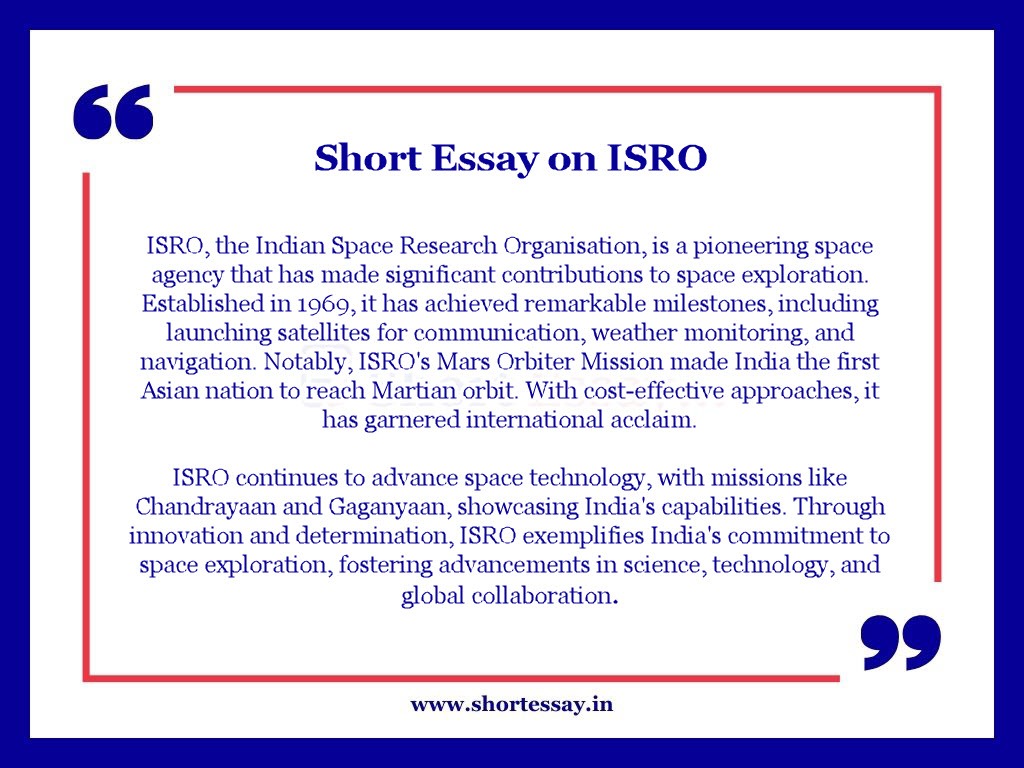
Table of Contents
Essay on ISRO in English in 10 Lines
“Explore the triumphs and advancements of the Indian Space Research Organization (ISRO) in this concise essay, highlighting its journey, achievements, and impact on space exploration and technology.”
- The Indian Space Research Organisation (ISRO) is India’s premier space agency, founded in 1969.
- ISRO’s primary objective is to harness space technology for national development and scientific research.
- It made history with its successful launch of Aryabhata, India’s first satellite, in 1975.
- The Mars Orbiter Mission (Mangalyaan) in 2013 marked ISRO’s remarkable achievement as the first Asian nation to reach Martian orbit.
- ISRO has excelled in cost-effective satellite launches, providing communication, weather, and navigation services.
- The Chandrayaan missions, exploring the moon, showcased India’s prowess in lunar exploration.
- ISRO’s consistent success has attracted global attention, fostering collaborations with various space agencies.
- The organization’s achievements include record satellite launches in a single mission, demonstrating efficiency and reliability.
- ISRO’s commitment to innovation is evident in projects like the reusable launch vehicle (RLV) and the ambitious Gaganyaan mission.
- With its visionary leadership, ISRO continues to play a pivotal role in advancing India’s space capabilities and contributing to global space exploration.
Essay on ISRO in 250 Words in English
“Delve into the inspiring journey and groundbreaking achievements of the Indian Space Research Organization – ISRO in this essay, exploring its significant contributions to space science, satellite technology, and India’s position in the global space community.”
The Indian Space Research Organization (ISRO) stands as a beacon of scientific and technological prowess, steering India’s voyage into the cosmos since its establishment in 1969. Founded with the vision of utilizing space technology for national development, ISRO has evolved into a global space player.
One of ISRO’s initial triumphs was the launch of Aryabhata, India’s first satellite, in 1975, marking the nation’s entry into the space age. Since then, ISRO has achieved numerous milestones, distinguishing itself with a series of successful satellite launches and groundbreaking missions.
Notably, the Mars Orbiter Mission, or Mangalyaan, launched in 2013, elevated ISRO’s status globally. India became the first Asian nation to reach Martian orbit and the first nation globally to succeed on its maiden attempt. This success showcased not only India’s technological prowess but also its ability to execute cost-effective space missions.
ISRO’s prowess extends to satellite technology, where it has excelled in launching satellites for communication, weather forecasting, navigation, and Earth observation. The organization’s commitment to affordability and efficiency is evident in its record-breaking launches, deploying multiple satellites in a single mission.
The Chandrayaan missions, exploring the moon, further demonstrated ISRO’s capabilities in lunar exploration. These missions expanded our understanding of the moon’s composition and geological features.
ISRO’s achievements have not only enhanced India’s self-reliance in space technology but have also fostered international collaborations. The organization continues to strive for innovation with projects like the reusable launch vehicle (RLV) and the ambitious Gaganyaan mission, aiming to send Indian astronauts into space.
Essay on ISRO 500 Words
“Embark on an in-depth exploration of the Indian Space Research Organization (ISRO) in this comprehensive 500-word Essay on ISRO, unraveling its historical evolution, groundbreaking achievements, and significant contributions to India’s space capabilities on the global stage.”
The Indian Space Research Organisation (ISRO) has emerged as a beacon of scientific and technological prowess, propelling India into the forefront of the global space community. Founded in 1969, ISRO’s journey has been marked by a series of groundbreaking achievements that have not only transformed India’s space capabilities but have also made notable contributions to international space exploration.
At its inception, ISRO’s vision was clear: to harness the potential of space technology for the country’s socio-economic development. The early years saw the successful launch of Aryabhata, India’s first satellite, in 1975, laying the foundation for a robust space program. This was followed by an array of communication and Earth observation satellites, each enhancing India’s technological capabilities and addressing critical societal needs.
However, it was in the 21st century that ISRO truly captured global attention with its Mars Orbiter Mission (Mangalyaan) in 2013. India became the first Asian nation to reach Martian orbit and the first in the world to do so in its maiden attempt. This historic achievement not only showcased India’s technological prowess but also highlighted ISRO’s cost-effective approach to space exploration.
ISRO’s prowess extends beyond Earth’s orbit. The Chandrayaan missions, dedicated to lunar exploration, have significantly contributed to our understanding of the Moon’s geology and composition. Chandrayaan-1, launched in 2008, made the remarkable discovery of water molecules on the lunar surface, marking a pivotal moment in space exploration.
In addition to exploration, ISRO plays a crucial role in providing essential services through its satellite programs. The constellation of communication satellites ensures widespread connectivity, while meteorological satellites aid in accurate weather forecasting, benefiting agriculture, disaster management, and various other sectors. Navigation satellites like the Indian Regional Navigation Satellite System (IRNSS), also known as NavIC, enhance precision in navigation and positioning applications.
ISRO’s commitment to innovation is evident in its endeavors like the reusable launch vehicle (RLV) and the ambitious Gaganyaan mission. The RLV project aims to reduce launch costs by creating a cost-effective, reusable spacecraft. On the other hand, Gaganyaan, slated to send Indian astronauts into space, signifies India’s entry into human spaceflight, marking a significant milestone in the nation’s space odyssey.
The organization’s achievements are not limited to its own endeavors. ISRO has become a reliable and cost-effective option for international satellite launches. The successful launch of numerous foreign satellites has established ISRO as a preferred partner for countries seeking access to space.
While ISRO has celebrated numerous triumphs, it has also faced challenges, including the occasional setback in mission attempts. However, these challenges have only served to strengthen ISRO’s resolve, fostering a culture of continuous improvement and resilience.
In conclusion, ISRO’s journey is a saga of dedication, innovation, and transformative achievements. From launching satellites for communication and remote sensing to exploring Mars and the Moon, ISRO has continually expanded the horizons of India’s space capabilities.
The organization’s commitment to advancing space technology for the benefit of humanity is not just a national achievement but a global contribution that exemplifies the power of science and human ingenuity. As ISRO looks toward the future with ambitious plans, it continues to inspire the world and shape the destiny of India’s presence in the cosmos.
Essay on ISRO in English in 1000 Words
“Embark on an extensive exploration of the Indian Space Research Organization (ISRO) in this comprehensive 1000-word Essay on ISRO, unraveling its historical evolution, technological milestones, international collaborations, and transformative impact on India’s space capabilities.”
India’s Cosmic Odyssey: A Comprehensive Exploration of ISRO
Introduction: The Genesis of ISRO
The Indian Space Research Organisation (ISRO) was established in 1969, marking a significant milestone in India’s foray into space exploration. Guided by the visionary Dr. Vikram Sarabhai, ISRO’s foundation aimed to harness space technology for national development and address societal needs.
Early Years and Foundation
In its early years, ISRO focused on building the foundation for a robust space program. The successful launch of Aryabhata, India’s first satellite, in 1975 marked a turning point. This satellite laid the groundwork for communication, Earth observation, and scientific research, setting the stage for ISRO’s future endeavors.
Evolution of ISRO’s Space Program
ISRO’s space program evolved rapidly, with a series of satellite launches enhancing India’s technological capabilities. The development of satellite technology became a cornerstone, providing essential services like telecommunications, weather forecasting, and resource monitoring. The INSAT series and IRS satellites played pivotal roles in transforming these aspirations into reality.
Mars Orbiter Mission (Mangalyaan)
The Mars Orbiter Mission (Mangalyaan), launched in 2013, catapulted India into the league of interplanetary explorers. Not only did Mangalyaan successfully enter Martian orbit, but it did so on its maiden attempt, making India the first Asian nation to reach Mars and the first in the world to do so at such a low cost. This mission showcased ISRO’s cost-effective approach and technological prowess on the global stage.
Lunar Exploration: Chandrayaan Missions
Building on its success with Mangalyaan, ISRO set its sights on lunar exploration. Chandrayaan-1, launched in 2008, made a historic discovery by finding water molecules on the Moon’s surface. The Chandrayaan-2 mission, with an orbiter, lander, and rover, further advanced India’s capabilities in lunar exploration, showcasing ISRO’s commitment to unraveling the mysteries of the cosmos.
Satellite Constellations for Societal Needs
ISRO’s satellite constellations serve as lifelines for various societal needs. Communication satellites like the INSAT/GSAT series have revolutionized connectivity across the country. Meteorological satellites provide accurate weather forecasting, aiding agriculture, disaster management, and infrastructure planning. Navigation satellites, including the Indian Regional Navigation Satellite System (IRNSS), known as NavIC, enhance precision in navigation and positioning applications.
Cost-Effective Innovation and Reusable Launch Vehicles
One of ISRO’s hallmarks is its ability to achieve cost-effective solutions without compromising on quality. The organization continually explores innovative approaches to reduce launch costs. The Reusable Launch Vehicle (RLV) project aims to create a cost-effective, reusable spacecraft, further cementing ISRO’s reputation as a leader in efficient space exploration.
Human Spaceflight: The Gaganyaan Mission
ISRO’s ambitious Gaganyaan mission represents a significant leap in India’s space program. Envisioned as India’s first manned space mission, Gaganyaan aims to send Indian astronauts into space. This mission not only showcases technological advancements but also reflects India’s aspirations to join the exclusive club of nations capable of human spaceflight.
International Collaborations and Commercial Launches
ISRO’s achievements extend beyond national borders, with a growing reputation for international collaborations and commercial launches. The organization actively collaborates with various space agencies, contributing to global space exploration efforts. Additionally, ISRO’s cost-effective launch services have made it a preferred choice for commercial satellite launches worldwide.
Challenges and Resilience
ISRO’s journey has not been without challenges. Setbacks, while inevitable in the realm of space exploration, have served as learning opportunities. From launch failures to technical glitches, ISRO has displayed resilience, learning from each experience and emerging stronger. This resilience has become a hallmark of the organization’s culture.
Conclusion: ISRO’s Continued Odyssey: Shaping India’s Cosmic Destiny
In conclusion, ISRO’s odyssey has been nothing short of extraordinary. From its humble beginnings to reaching the frontiers of interplanetary exploration, ISRO has showcased India’s technological prowess and resilience. The organization’s commitment to addressing societal needs through space technology, its innovative solutions, and its forays into lunar and Martian exploration have positioned India as a key player in the global space community. As ISRO continues its cosmic journey, it not only shapes India’s destiny in space but also inspires the world with its unwavering dedication to the pursuit of knowledge and exploration.
This Essay on ISRO has explored the multifaceted journey of the Indian Space Research Organization (ISRO), from its nascent stages to its current standing as a global space powerhouse.
ISRO’s remarkable achievements, cost-effective innovations, and unwavering commitment to space exploration have not only transformed India’s technological landscape but have also made significant contributions to our understanding of the cosmos. As ISRO continues its cosmic odyssey, it stands as a symbol of India’s indomitable spirit and scientific prowess on the world stage.
Related Essays

Essay on Modern Indian Woman – 100, 500, 1000 Words, 10 Lines

Essay on Future of English in India – 10 Lines, 500 & 1000 Words

Essay on Bhai Dooj – 10 Lines, 100, 500, 1000 Words

Essay About Ooty – 10 Lines, 500 & 1000 Words

Draupadi Murmu Essay – 10 Lines, 100, 500, 1000 Words

Computer Essay – Short Essay, 10 Lines, 500 & 1000 Words
Leave a comment cancel reply.
Save my name, email, and website in this browser for the next time I comment.

Indian Space Research Organisation (ISRO), Achievements & Challenges
Indian Space Research Organisation (ISRO), is the Indian space agency of the Department of Space, based in Bengaluru, Karnataka. Read all about ISRO, History, Achievements, Challenges for UPSC Exam.

Table of Contents
Indian Space Research Organisation (ISRO)
Indian Space Research Organisation, or ISRO, is the country of India’s space agency. It was established in 1969 to support the creation of an indigenous space project in India. The Department of Space of the Government of India oversees ISRO, a space agency with headquarters in Bengaluru, Karnataka. Its goal is to pursue planetary exploration, space science research, and national development via space technology. Antrix Corporation Limited (ACL), the marketing division of ISRO, is in charge of commercialising space products, providing technical consulting services, and transferring innovations created by ISRO.
Currently, ISRO is among the top six space agencies in the world. Through a network of centres, offices, and research institutes dispersed around the nation, ISRO serves the needs of the country by maintaining one of the largest fleets of remote sensing (IRS) and communication (INSAT) satellites in the world. Broadcasting, weather forecasting, disaster management, geographic information systems, navigation, cartography (maps), telemedicine, remote education satellites, and other services are all provided by ISRO.
Chandrayaan-3 Mission
Chandrayaan-3 is a follow-on mission to Chandrayaan-2 to demonstrate end-to-end capability in safe landing and roving on the lunar surface. LVM3 M4 vehicle successfully launched Chandrayaan-3 into orbit on July 14, 2023. Chandrayaan-3 successfully soft-landed on the south pole of the moon’s surface on August 23, 2023, and the Pragyaan Rover ramped down from the Vikram Lander and India took a walk on the moon on August 24, 2023. For detailed information about Chandrayaan-3 Mission click here.
Upcoming Missions of ISRO
The following are some of the upcoming ISRO Missions:
Indian Space Research Organisation (ISRO) Background
Dr. Vikram Sarabhai, the man responsible for launching India’s space project in the 1960s, started space research activities there. Three main elements have been a part of the Indian space project from the beginning: communication and remote sensing satellites, the space transportation system, and application programmes.
Dr. Ramanathan and Dr. Sarabhai established INCOSPAR (Indian National Committee for Space Research). SITE, or Satellite Instructional Television Experiment, was run in 1975–1976. It was referred to as “the largest sociological experiment ever.” Following it was the “Kheda Communications Project (KCP),” which acted as a field laboratory for need-based and location-specific programme transmission in Gujarat.
The Department of Space was founded in 1972, although INCOSPAR was renamed the Indian Space Research Organisation in 1969 (now, ISRO is a division of the Department of Science). The following are the pivotal moments in ISRO history:
- The greatest sociological experiment ever done, SITE (Satellite Instructional Television Experiment), took place in 1975–1976.
- Gujarat is where the Kheda Communications Project was founded. The undertaking served as a field lab.
- In addition, ISRO created and launched Aryabhata, the first Indian spacecraft, utilising a Soviet launch vehicle.
- In 1980, SLV-3 made its maiden successful flight.
- Apple introduced the first satellite-based communication system.
- Antrix Corporation Limited (ACL), the ISRO’s marketing division, was established to advance and sell the use of space products.
- ISRO built a few specialised centres. These include the Vikram Sarabhai Space Centre (VSSC) and the Liquid Propulsion Systems Centre (LPSC) in Thiruvananthapuram, as well as the National Remote Sensing Centre (NRSC) in Hyderabad, the Space Applications Centre (SAC) in Ahmedabad, and the Satish Dhawan Space Centre (SDSC-SHAR) in Sriharikota.
ISRO Achievements
Since the Indian Space Research Organisation was founded, its employees have worked very hard to accomplish its goals. The following missions were successfully launched by ISRO:

Communication Satellites
With nine operational communication satellites in Geostationary orbit launched by the Indian Space Research Organisation (ISRO), the Indian National Satellite (INSAT) system, which went into service in 1983 with the commissioning of INSAT-1B, is one of the largest domestic communication satellite systems in the Asia-Pacific region.
The communications market in India underwent a significant transition as a result, which it sustained throughout time. The INSAT system supports telecommunications, satellite news gathering, television transmission, societal applications, weather forecasting, disaster warning, and search and rescue activities. Here are some of ISRO’s key communication satellites:
Earth Observation Satellites
Since the launch of IRS-1A in 1988, ISRO has launched a number of operational remote-sensing satellites. One of the largest satellite constellations for remote sensing is now run by India. Different instruments have been constructed and flown onboard to serve various national and international purposes in order to deliver the essential data at diversified temporal, spectral, and geographical resolutions. These satellites’ data are then utilised by ISRO for a variety of purposes, including disaster management, the management of ocean resources, forestry, environmental protection, mineral prospecting, rural development, urban planning, water resources, and agriculture.
The table below includes a list of ISRO’s significant Earth observation satellites, together with information about their launch vehicle and the date of launch:
Navigation Satellites
The Airport Authority of India (AAI) and ISRO are collaborating to build the GPS Aided Geo Augmented Navigation (GAGAN) system in order to meet the requirements of Civil Aviation. Indian Regional Navigation Satellite System (IRNSS) is a regional satellite navigation system being established by ISRO in order to satisfy customer requirements for positioning, navigation, and timing services based on indigenous technology.
Experimental Satellites
Many small satellites, usually for research, have been launched by ISRO. This experiment makes use of payload development, orbit controls, atmospheric research, remote sensing, and recovery technology. The following is a list of the key experimental satellites that ISRO has launched:
Small Satellites
The small satellite project will soon offer a platform for standalone payloads for science and earth imaging missions. The Indian Space Research Organisation (ISRO) has developed two different bus types, the Indian Mini Satellite -1 (IMS-1) and Indian Mini Satellite – 2 (IMS-2), to offer a versatile platform for different payloads.
Here is a list of the small satellites that ISRO has launched:
Space Science & Exploration Satellites
Satellites fall within this group: The first dedicated Indian astronomy mission, AstroSat, studies celestial sources simultaneously in the X, optical, and UV spectral bands. The true first interplanetary mission of ISRO, the Mars Orbiter Mission (MOM), was launched on November 5, 2013. Both Chandrayaan-1 and Chandrayaan-2, India’s first and second moon missions, included an orbiter, a lander, a rover, and other components.
Academic Institute Satellites
Educational institutions have been impacted by ISRO operations, such as the development of connectivity, remote sensing, and astronomy satellites. Universities and other organisations have been more interested in creating experimental student satellites as a result of the Chandrayaan-1 launch.
Here is a table listing the ISRO-launched academic institute satellites:
Scramjet (Supersonic Combusting Ramjet) Engine
The Supersonic Combusting Ramjet Engine Test, or Scramjet, was successfully completed by ISRO in August 2016. The fuel for the Scramjet engine is hydrogen, while the oxidizer is oxygen from the surrounding air. With a longer flight time, the new propulsion system will enhance ISRO’s reusable launch vehicle.
Indian Space Research Organisation (ISRO) Objective
ISRO has the ambition to develop space technology for the benefit of the country and to conduct planetary exploration and space science research. The following are the main goals of ISRO:
- The Small Satellite Launch Vehicle (SSLV), Geosynchronous Satellite Launch Vehicle (GSLV), and Polar Satellite Launch Vehicle (PSLV) operational flights.
- To plan, create, and launch communication and earth observation satellites.
- Designing and developing fresh approaches to space transportation is another important goal of ISRO.
- To create satellites for planetary exploration and space science, as well as satellite navigation systems.
- To create tools for more accurate earth observation.
- To develop a system based on space for use in society.
- Developing proper training, education, and capacity-building programmes for students interested in space technology is one of ISRO’s main goals.
Indian Space Research Organisation (ISRO) Challenges and Opportunities
Even though ISRO’s success stories are celebrated all over the world, the organisation still faces obstacles in accomplishing its objectives. The Indian Space Programme has the following problems and opportunities:
- India is not in a situation where it is facing specific security and development concerns since it is a developing nation. For instance, ISRO is called into question and forced to defend the funding for missions that need a lot of work but have little to do with development.
- Since China tested an anti-satellite missile (ASAT) in 2007, the country has upped the threat level. In addition to the one on the ground, it can start in space. There have been military weaknesses since India relied on satellites like MOM.
- The US or other nations must cooperate with the DRDO while it develops a missile.
- China launched the satellite in 2011 and 2012 to target Pakistan and Sri Lanka.
Indian Space Research Organisation (ISRO) UPSC
One of the most significant scientific institutions in the nation and a recent boon to India is ISRO. The ISRO-launched satellites have been successful in gathering the needed information, making them a crucial component of India’s development. Being so important for the nation, it is also a key subject for UPSC hopefuls because many questions from the ISRO UPSC notes are asked in the IAS Exam.
Sharing is caring!
Indian Space Research Organisation (ISRO) FAQs
What does isro stands for.
The Indian Space Research Organisation, or ISRO, is the country's space agency and is located in Bengaluru, Karnataka. The ISRO's goal is to perform planetary exploration and space science research while using space technologies to advance national development.
Is Chandrayaan-3 successful?
"India successfully launches Chandrayaan-3 marking another significant milestone in space exploration.
How many centres are there in ISRO?
There are six main centres within ISRO. These include the Liquid Propulsion Systems Centre (LPSC), the Vikram Sarabhai Space Centre (VSSC), the National Remote Sensing Centre (NRSC), the Space Applications Centre (SAC), the Satish Dhawan Space Centre (SDSC-SHAR), and the National Remote Sensing Centre (NRSC) in Hyderabad.
When was ISRO Formed?
On August 15, 1969, Dr. Vikram A. Sarabhai founded ISRO. The Indian government did, however, create the Department of Science and the Space Commission in 1972. ISRO was established under the Department of Science on June 1st, 1972.
What is main Objective of ISRO?
The Indian Space Research Organization's main goal is to create space technology in order to meet various national demands. To accomplish this, ISRO has created INSAT and the Indian Remote Sensing Satellite System.
- science and tech

Leave a comment
Your email address will not be published. Required fields are marked *
Save my name, email, and website in this browser for the next time I comment.

- UPSC Online Coaching
- UPSC Exam 2024
- UPSC Syllabus 2024
- UPSC Prelims Syllabus 2024
- UPSC Mains Syllabus 2024
- UPSC Exam Pattern 2024
- UPSC Age Limit 2024
- UPSC Calendar 2024
- UPSC Syllabus in Hindi
- UPSC Full Form

Recent Posts
- UPPSC Exam 2024
- UPPSC Calendar
- UPPSC Syllabus 2024
- UPPSC Exam Pattern 2024
- UPPSC Application Form 2024
- UPPSC Eligibility Criteria 2024
- UPPSC Admit card 2024
- UPPSC Salary And Posts
- UPPSC Cut Off
- UPPSC Previous Year Paper
BPSC Exam 2024
- BPSC 70th Notification
- BPSC 69th Exam Analysis
- BPSC Admit Card
- BPSC Syllabus
- BPSC Exam Pattern
- BPSC Cut Off
- BPSC Question Papers
IB ACIO Exam
- IB ACIO Salary
- IB ACIO Syllabus
CSIR SO ASO Exam
- CSIR SO ASO Exam 2024
- CSIR SO ASO Result 2024
- CSIR SO ASO Exam Date
- CSIR SO ASO Question Paper
- CSIR SO ASO Answer key 2024
- CSIR SO ASO Exam Date 2024
- CSIR SO ASO Syllabus 2024
Study Material Categories
- Daily The Hindu Analysis
- Daily Practice Quiz for Prelims
- Daily Answer Writing
- Daily Current Affairs
- Indian Polity
- Environment and Ecology
- Art and Culture
- General Knowledge
- Biographies

IMPORTANT EXAMS

- Terms & Conditions
- Return & Refund Policy
- Privacy Policy
Essay On ISRO For Students In Easy Words
- January 8, 2022
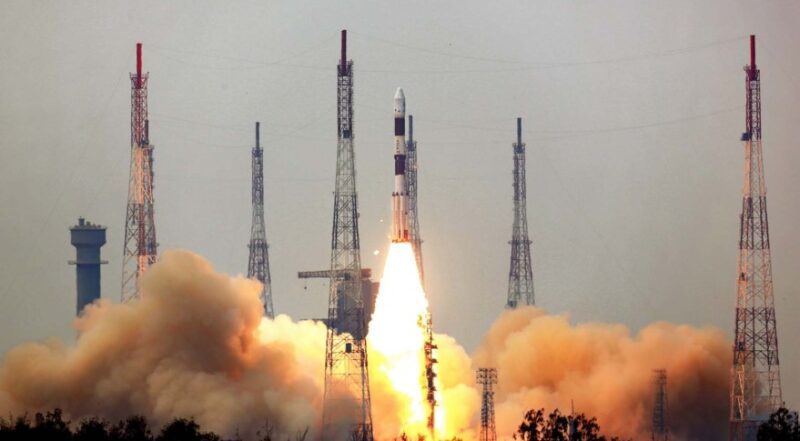
ISRO is the abbreviation of Indian Space Research Organisation. It is an intergovernmental organization, founded in 1969 by India’s first Prime Minister, Jawaharlal Nehru.
The isro achievements is a essay about how India’s space agency, the Indian Space Research Organization (ISRO), has been able to achieve success in its endeavors.
Introduction:
The Indian Space Research Organization (ISRO) is a department that the whole nation is proud of. It is only because of this organization that India has accomplished so much in space today.
ISRO Stands for International Space Station Research Organization.
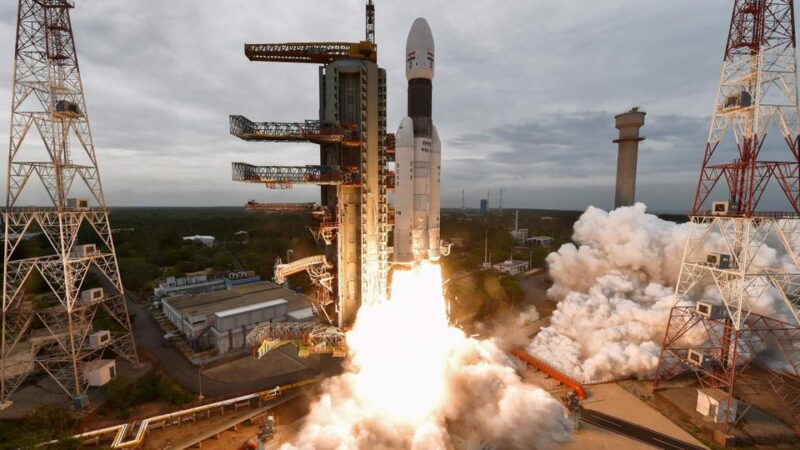
This organization and its hard work are well known in India, and now we will tell you more about it. ISRO, or the Indian Space Research Organization, works for the government and provides all of the necessary resources for space research.
We are now one of the most inspirational nations in the world just because of the individuals that work so hard at ISRO. I’ve completed a slew of impossible tasks without even the benefit of good instruction. The difficulties were unending, and there seemed to be no way out, yet people eventually came up with alternative solutions.
Who Was the Founder of ISRO?
Well, this is a critical issue that every Indian must consider. A brilliant guy named APJ Abdul Kalam founded the Indian Space Research Organization, and he was the organization’s first scientist. Today, any accomplishments we have as a company are all due to this outstanding leader.
ISRO was established relatively late after independence since there was no adequate financing for space research in India. Slowly and steadily, when the Indian government realized that being in space might strengthen our nation, they began to invest in it.
ISRO’s missions were enormously successful, and many nations are still attempting to attain that objective. And we, as Indians, never underestimate any of them; whomever begs for assistance, we always go out of our way to assist them with whatever resource or knowledge they need.
Indian Space Research Organization’s Achievements
When it comes to ISRO’s accomplishments, there are a lot of them. The accomplishments of building their own rocket and even launching it from their own Launchpad.
There are still nations attempting to launch their own rockets from the launching site. They are still reliant on others to do so. Because to India’s space research agency and its dedicated workers, the country has received many honors.
Today, every child in India wants to join ISRO, and it is a great pleasure for every Indian to be a part of this amazing organization. Today, people are attempting to make more and more tough tasks simpler.
The ISRO is providing invaluable assistance to the whole globe, ensuring that no one has to experience the challenges that India has previously overcome. As a result, ties between India and other nations have significantly improved.
If you have any more queries about the ISRO Essay, please leave them in the comments section below.
The isro history is a short essay on the Indian Space Research Organization. It explains how it was founded and what its goals are.
Related Topics
- space agency
Essay on Kho-Kho Game in English For Students in Easy Words

Essay On Indian Festival Diwali For Students In Easy Words – Read Here
- January 9, 2022
Input your search keywords and press Enter.
- Jupiter Moons
- Saturn Moons
- Uranus Moons
- Neptune Moons
- Asteroid Belt
- Kuiper Belt
- Milky Way Galaxy
- Andromeda Galaxy
- Rogue Planets
- Fundamental Forces
- Fundamental Particles
- About Universe
- Astro-Buyer
Everything about ISRO: History and Mission
- by Planets Education
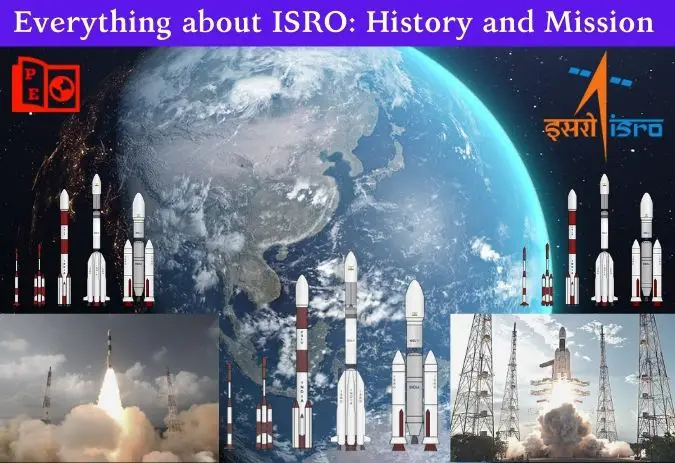
ISRO (Indian Space Research Organisation) is one of the leading space agencies in the world. Starting from zero, it has come to the fifth rank among the world’s top space agencies.
It has been almost 60 years since the Indian National Committee for Space Research (INCOSPAR) was established, and later it was given the name Indian Space Research Organisation (ISRO).
ISRO has achieved so many records in its journey including the launch of 104 satellites in a single rocket in 2017. In 2013, ISRO launched a spacecraft “ Mangalyaan ” into orbit of the Mars Planet , and it made India become 1st country to reach Mars at its very first attempt.
- While considering budgets and space missions only four countries (USA, China, Europe, and Russia) are ahead of this agency.
Here in this article, you will read everything about ISRO, from the origin and history of ISRO to its future missions. We have mentioned “everything you need to know about ISRO” from the student’s point of view and for the general knowledge point of view in a proper and well-organized manner.
History of ISRO and Past Missions
Here in this section, we have mentioned some ISRO information including their history and past missions:
Every technology and its industry has a time in their past when they were not even in existence. Same as ISRO, there was nothing like a space agency in India before 1962.
When space missions of the Soviet Union and the United States were in the experimental stage, Dr. Vikram Sarabhai understood the importance of space technology in India.
Under the supervision of the Department of Atomic Energy (DAE) and scientist Vikram Sarabhai, India established its first space agency “ Indian National Committee for Space Research” (INCOSPAR) in 1962. The goal of this agency was to establish space technology for national development including planetary exploration and space science research.
First Sounding Rocket Launch
In 1963 Thumba Equatorial Rocket Launching Station (TERLS) was established at Thumba near Thiruvananthapuram, Kerala. On 21 November 1963, India launches its first sounding rocket from TERLS.
This rocket was imported from Russia (M-100). And thus India started the journey for space research programs.
- A sounding rocket sometimes called a research rocket, is small in size and uses less propellant to research the upper atmospheric region .
In 1965 INCOSPAR started making Indian-sounding rockets. They launched many Indians made solid propellant rockets and gained experience in this technology.
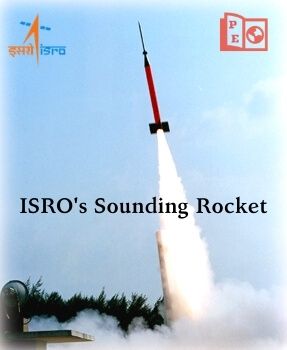
INCOSPAR become ISRO
On independence day 15 August 1969, INCOSPAR (Indian National Committee for Space Research) changed its name and become ISRO (Indian Space Research Organization) .
Launched the first Indian satellite
ISRO made its first satellite “Aryabhata” in name of Indian mathematician and astronomer Aryabhata .
On 19 April 1975, ISRO launched its first satellite Aryabhata with help of the Russian-made launch vehicle Kosmos-3M (C-1 Intercosmos) in Kapustin Yar Russia. The satellite was just an experimental satellite with 360 kilograms.
On 7 June 1979, the first experimental remote sensing satellite Bhaskara-I launched, in the same site Kapustin Yar Russia with the same launch vehicle C-1 Intercosmos.
Development of SLV and Rohini Series
Indians started to make their own Launch Vehicle and they developed the first Satellite Launch Vehicle (SLV) in 1979. They launch their first rocket SLV-3 on 10 August 1979, carrying the “Rohini Technology Payload (RTP)” satellite. This mission of ISRO was unsuccessful. Whereas the first successful SLV-3 launch mission happened on 18 July 1980 that carried Rohini Satellite RS-1.
After that, with the help of the SLV-3 launcher, ISRO launched two Rohini series satellites: Rohini Satellite RS-D1 on 31 May 1981 and Rohini Satellite RS-D2 on 18 April 1983. These satellites were launched for the purpose of Earth ’s observation.
Launch of the APPLE satellite
19 July 1981, They launched APPLE (Ariane Passenger Payload Experiment) with the help of Ariane -1(V-3) launch vehicle. APPLE was India’s first experimental geostationary communication satellite.
On 20 Nov 1981, they launched Experimental Remote Sensing Bhaskara II with a C-1 Intercosmos launcher.
INSAT Series Satellites
After the above-mentioned history of the ISRO mission, they started to build INSAT (Indian National Satellite System) series satellites. On 10 April 1982, ISRO launched the INSAT-1A satellite with help of the Delta launch vehicle. This mission was unsuccessful because the altitude control propellant got exhausted in the orbit.
After that many INSAT series satellites have been launched successfully with help of different launchers. These satellites are:
INSAT-1B (30 Aug 1983), NSAT-1C (22 Jul 1988), INSAT-1D (12 Jun 1990), INSAT-2A (10 Jul 1992), INSAT-2B (23 Jul 1993), INSAT-2C (07 Dec 1995), INSAT-2D (04 Jun 1997), INSAT-2E (03 Apr 1999), INSAT-3B (22 Mar 2000), INSAT-3C (24 Jan 2002), INSAT-3A (10 Apr 2003), INSAT-3E (28 Sep 2003), INSAT-4A (22 Dec 2005), INSAT-4C (10 Jul 2006), INSAT-4B (12 Mar 2007), INSAT-4CR (02 Sep 2007).
INSAT series satellites are multipurpose geostationary satellites, help in many sectors such as telecommunications, broadcasting, meteorology, and search-and-rescue needs of India.
Development of ASLV and SROSS satellites series
After the launch of INSAT-1B, ISRO developed an advanced launch vehicle than SLV and it was called the Augmented Satellite Launch Vehicle (ASLV) . The first launch of ASLV with the SROSS-1 satellite was unsuccessful. It was launched from Satish Dhawan Space Centre (SDSC) SHAR Sriharikota, and could not reach the orbit.
And then some other SROSS series satellites launched by ISRO in upcoming years. These satellites were:
SROSS-2 (13 Jul 1988), SROSS-C (20 May 1992), SROSS-C2 (04 May 1994).
IRS Series Satellites
ISRO started to develop Indian Remote Sensing (IRS) Satellites after the launch of SROSS-1. On 17 March 1988, ISRO started its mission for the indigenous state-of-art remote sensing satellite (IRS-1A) on the Vostok launcher of Russia.
After that, they launched many IRS series satellites, such as IRS-1B (29 Aug 1991), IRS-1E (20 Sep 1993), IRS-P2 (15 Oct 1994), IRS-1C (28 Dec 1995), IRS-P3 (21 Mar 1996), IRS-1D (29 Sep 1997), Ocean-sat (IRS-P4) (26 May 1999).
Time of PSLV launch vehicle
Indian Space Research Organization started to develop Polar Satellite Launch Vehicle (PSLV) after 1990. This PSLV launch vehicle contributed to many achievements for ISRO.
Though the first launch of PSLV-D1 with IRS-1E on 20 Sep 1993 was unsuccessful. Whereas the second launch of PSLV-D2 with IRS-P2 satellite was done on 15 Oct 1994 and it placed the satellite successfully in Polar Sun-synchronous Orbit. Then it launched many IRS series satellites.
After this, ISRO got many achievements with help of the PSLV rockets. Some famous satellite launches of India with PSLV are KALPANA-1, Chandrayaan-1, and Mars Orbiter Mission (Mangalyaan). And one of the best famous facts about ISRO’s launch happened on 15 Feb 2017 with PSLV-C37 when it carries and launched 104 satellites in a single go. Still, PSLV is one of the favorite launch vehicles of the ISRO.
Time of GSLV and GSAT satellites
Geosynchronous Satellite Launch Vehicle (GSLV) is an expendable launch system operated by ISRO and it is used to place the satellites in Geo-Synchronous Transfer Orbit (GTO). On 18 Apr 2001, GSLV-D1 got launched for the first time and carried the experimental communication satellite, GSAT-1.
After that, ISRO launched many GAST satellites either with help of GSLV or other launch vehicles. These GSAT satellites are given below in order of time:
GSAT-2 (8 May 2003), GSAT-4 (15 Apr 2010), GSAT-5P (25 Dec 2010), GSAT-8 (21 May 2011), GSAT-12 (15 July 2011), GSAT-10 (29 Sep 2012), GSAT-7 (30 Aug 2013), GSAT-14 (05 Jan 2014), GSAT-16 (07 Dec 2014), GSAT-6 (27 Aug 2015), GSAT-15 (11 Nov 2015), GSAT-18 (06 Oct 2016), GSAT-9 (05 May 2017), GSAT-19 (05 Jun 2017), GSAT-17 (29 Jun 2017), GSAT-6A (29 Mar 2018), GSAT-29 (14 Nov 2018), GSAT-11 Mission (05 Dec 2018), GSAT-7A (19 Dec 2018), GSAT-31 (06 Feb 2019), GSAT-30 (Most recent launch of ISRO till this article is written, 17 Jan 2020).
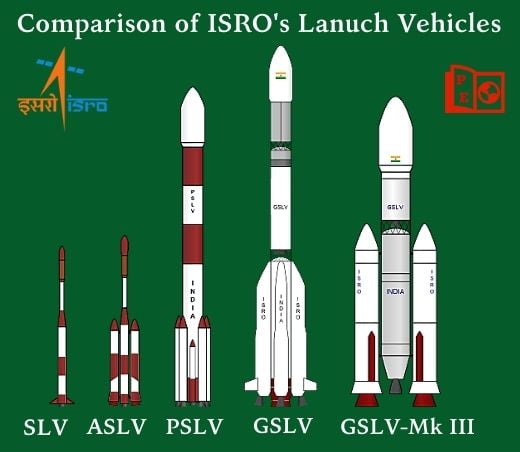
Some special satellites of ISRO
Those above-mentioned satellites and their launch vehicles are just not enough. Talking about the history of ISRO or its launched satellites in the past, this space agency has achieved much more in the field of space science.
While considering ISRO history, some other incidents and special satellites launched by ISRO are given below:
On 12 Sep 2002, ISRO launched a satellite KALPANA-1. This satellite was named after the Indian-born American Astronaut Kalpana Chawla . It was ISRO’s first meteorological satellite, launched by PSLV-C4 from Satish Dhawan Space Centre, Sriharikota.
On 20 Sep 2004, ISRO launched its first dedicated educational satellite EDUSAT, also known as GSAT-3.
Chandrayaan-1:
On 22 Oct 2008, India’s first mission to the moon the Chandrayaan-1 lunar probe was launched by the ISRO. And this was the first time India go for Extraterrestrial observation. PSLV-C11 rocket was used to launch this spacecraft.
ISRO started the Indian Regional Navigation Satellite System (IRNSS) series of satellites and IRNSS-1A was the first one. IRNSS satellites also known as NAVIC (Navigation with Indian Constellation) and are used in the application of real-time positioning and timing services. IRNSS-1A was India’s first dedicated navigation satellite and was launched on 01 Jul 2013 with the PSLV-C22 launch vehicle.

Mars Orbiter Mission (MOM or Mangalayaan):
On 5 Nov 2013, ISRO made a world record, after launching the Mangalyaan spacecraft with help of a PSLV-C25 rocket. Mangalyaan was India’s first interplanetary mission to planet Mars . Indian Space Research Organisation (ISRO) is the only space agency in the world to reach on Mars in a single attempt.
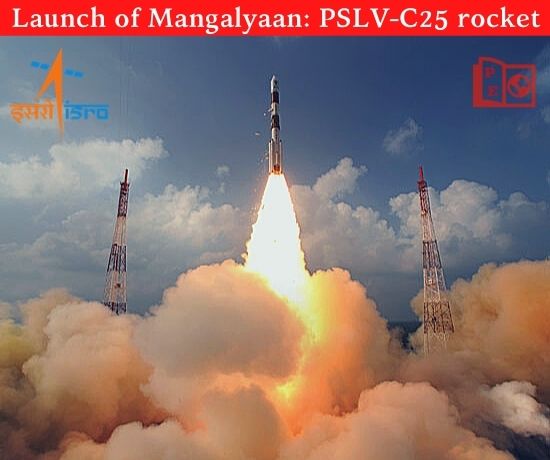
PSLV-C37 with Cartosat -2 Series Satellite:
On 15 Feb 2017, ISRO got one record achievement again while launching 104 satellites on a single rocket PSLV-C37. It carried 3 Indian satellites and 101 international satellites. ISRO broke the record of the Russian Dnepr rocket for launching 37 satellites in a single go, on 19 June 2014.
Chandrayaan-2:
Chandrayaan-2 was launched on 22 Jul 2019 with help of the “GSLV-Mk III – M1” launch vehicle. It was the second mission of India to the moon. This mission of ISRO has a lunar orbiter, a Vikram lander, and a Pragyan lunar rover. All the parts of the orbiter, lander, the rover of Chandrayaan-2 were developed in India.
These were some special spacecraft of ISRO while considering the history of ISRO and past missions.
A special fact about ISRO is, in the starting time they used cycles and bullock-cart to shift the rockets from one place to another. And now ISRO is leading to become one of the top space agencies in the world.
I hope you have liked reading this article “Everything about ISRO: History and Mission”, ISRO information and ISRO missions including its history. Do comment on your point of view about this space agency.
ISRO’s next missions and ISRO future missions will be updated soon in the article “Everything about ISRO”.
Resources: Credits for Images and most information about ISRO goes to ISRO- Government of India.
Also Check:-
- Orbit of the International Space Station (ISS)
- All 8 Planet Facts and Solar System Planets in Order
- Kepler-186f: 1st Earth-Like Habitable Planet

1 thought on “Everything about ISRO: History and Mission”
Pingback: DAILY CURRENT AFFAIRS IAS | UPSC Prelims and Mains Exam – 31st March 2023 | IASbaba
Comments are closed.

67. ISRO: Exploring the Boundless Universe: A Journey Through ISRO’s Remarkable Achievements
Introduction.
In the vast expanse of the cosmos, one organization stands out for its remarkable contributions to space exploration – the Indian Space Research Organisation (ISRO). With a rich history spanning several decades, ISRO has not only placed India on the global space map but has also left an indelible mark on space science and technology. In this article, we will delve into the incredible world of ISRO, exploring its origins, key milestones, current projects, and its vision for the future.
Table of Contents

The Genesis of Indian Space Research Organisation
1. birth of a space dream.
ISRO’s journey began in 1969 when India’s first satellite, Aryabhata, was launched into space. This marked the inception of India’s space program, with a vision to harness space technology for peaceful purposes.
2. The Visionary Behind Indian Space Research Organisation
The driving force behind ISRO’s success was Dr. Vikram Sarabhai, the founding father of India’s space program. His vision and dedication laid the foundation for ISRO’s future endeavors.
Indian Space Research Organisation’s Milestones
3. mangalyaan – india’s martian odyssey.
In 2013, ISRO achieved a historic feat by successfully launching the Mars Orbiter Mission, or Mangalyaan. India became the fourth space agency in the world to reach Mars, and ISRO did it on its maiden attempt.
4. Chandrayaan – Exploring the Moon
ISRO’s Chandrayaan missions have been instrumental in lunar exploration. Chandrayaan-1’s discovery of water molecules on the Moon’s surface was a significant scientific breakthrough.
5. PSLV – The Workhorse Launcher
The Polar Satellite Launch Vehicle (PSLV) has been ISRO’s reliable workhorse, launching numerous satellites for both domestic and international customers.
6. GSLV – Geosynchronous Satellite Launch Vehicle
ISRO’s GSLV program has enabled the launch of communication satellites into geostationary orbits, bolstering India’s communication infrastructure.
Indian Space Research Organisation’s Current Endeavors
7. navic – india’s own navigation system.
ISRO’s Navigation with Indian Constellation (NavIC) system has strengthened India’s position in satellite-based navigation and location-based services.
8. Gaganyaan – India’s Manned Space Mission
ISRO’s ambitious Gaganyaan mission aims to send Indian astronauts to space, marking a historic milestone for the organization.
Indian Space Research Organisation’s Vision for the Future
9. expanding international collaborations.
ISRO continues to collaborate with international space agencies, fostering global cooperation in space exploration.
10. Sustainable Space Practices
ISRO is committed to sustainable space practices, including debris management and environmental protection.
11. Advancements in Space Technology
The organization is actively researching and developing cutting-edge technologies to further its space exploration capabilities.
In the world of space exploration, ISRO’s journey is nothing short of inspiring. From humble beginnings to reaching distant planets, ISRO has exemplified what can be achieved through dedication, innovation, and collaboration. As India’s space program continues to reach for the stars, ISRO’s legacy as a pioneering force in space exploration is set to endure.
1. How did Indian Space Research Organisation get its start?
Indian Space Research Organisation’s journey began in 1969 with the launch of India’s first satellite, Aryabhata, marking the inception of India’s space program.
2. What is the significance of the Mars Orbiter Mission (Mangalyaan)?
Mangalyaan, India’s Mars Orbiter Mission, made history by successfully reaching Mars on its maiden attempt, making Indian Space Research Organisation the fourth space agency in the world to achieve this feat.
3. What are some of Indian Space Research Organisation’s notable achievements in lunar exploration?
Indian Space Research Organisation’s Chandrayaan missions have made significant discoveries on the Moon, including the presence of water molecules on its surface.
4. How does Indian Space Research Organisation contribute to satellite-based navigation?
Indian Space Research Organisation’s Navigation with Indian Constellation (NavIC) system strengthens India’s position in satellite-based navigation and location-based services.
5. What is Indian Space Research Organisation’s vision for the future of space exploration?
Indian Space Research Organisation aims to expand international collaborations, promote sustainable space practices, and advance space technology to further its exploration capabilities.
Search us on Google by typing Interestopedia.com
Tap to open Google
Previous Post
1 thought on “67. ISRO: Exploring the Boundless Universe: A Journey Through ISRO’s Remarkable Achievements”
Pingback: 68. Asia Cup 2023: A Cricket Extravaganza in the Heart of Asia - Interestopedia
Leave a Comment Cancel Reply
Your email address will not be published. Required fields are marked *
Save my name, email, and website in this browser for the next time I comment.

Essay on ISRO (Indian Space Research Organization)
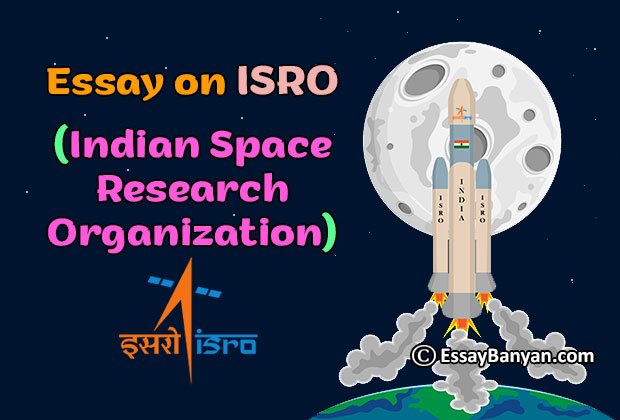
ISRO stands for Indian Space Research Organization; it is a space agency that comes under the Department of Space (DOS). ISRO is known for conducting economical programs and is responsible for managing space affairs in India. One of the main achievements is conducting a successful landing on Mars on the first attempt also being the least expensive Mars Mission in the world. ISRO is also responsible to carry out communication satellites and is supposed to work with DRDO to watch out for the security of India.
Short and Long Essay on ISRO in English
Here is a long essay mentioning the history and importance of ISRO to India.
10 Lines Essay on ISRO (100-120 Words)
1) The space-related affairs of India are managed by an agency known as ISRO.
2) ISRO (Indian Space Research Organization) was set up on 15 August 1969.
3) The headquarters of ISRO reside in Bangalore.
4) ISRO’s current serving chairman is Shri S. Somanath (2022).
5) Aryabhatt is India’s first satellite developed by ISRO.
6) ISRO has discovered two moon missions.
7) DoS or the Department of Space is responsible for monitoring and managing ISRO.
8) Recently, ISRO has successfully completed Mars Mission.
9) IRS, INSAT, GAGAN, etc are some pride projects of ISRO.
10) ISRO holds 5 launch vehicles out of which three are operational launch vehicles.
Long Essay on Indian Space Research Organization – 1300 Words
Introduction
ISRO is also called Bhartiya Antariksh Anusandhan Sangathan in Hindi. It is directly seen by the Prime Minister of India. The current chairman, Dr. Kailasavadivoo Sivan also known as K Sivan is also an executive member of the Department of Space (DOS). ISRO holds the record for being one of the agencies with Full Launch capabilities, the ability to launch extraterrestrial missions and can operate a big cortege of artificial satellites.
ISRO boasts 5 launch vehicles namely Satellite Launch Vehicle (SLV), Augmented Satellite Launch Vehicle (ASLV), Polar Satellite Launch Vehicle (PSLV), Geosynchronous Launch Vehicle (GSLV) and Geosynchronous Launch Vehicle Mark III (GSLV-MK III). Among those, 3 are operational launch vehicles which are mentioned below-
- PSLV – Stands for Polar Satellite Launch Vehicle, it is a third generation launch vehicle and was first launched in the year 1994. Till 2017, it has launched 257 satellites in which 48 are Indian satellites and 209 are foreign. It is well known for its successful launch of Mars Orbiter Spacecraft in 2013 and Chandrayan-1 in2008.
- GSLV – Also known as Geosynchronous Launch Vehicle Mark II (MKII) was launched first on 18 th April 2001. Since then it has been in 13 missions and holds the record for having success in 4 missions consecutively.
- GSLV-MK III – Was chosen to launch the Chandrayan II and has the twice the capacity of GSLV MK II and was launched in the year 2014 for the first time.
History of ISRO
Earlier scientists like S.K. Mitra, C.V. Raman, and Meghnad Saha used to carry space programs. Later Vikram Sarabhai founded Physical Research Laboratory at Ahmedabad. Homi Bhabha established the Tata Institute of Fundamental Research in 1945.
In 1962, the urge of the Indian National Committee for Space Research (INCOSPAR) was established by PM Jawaharlal Nehru. Later in 1963 sounding rocket was launched from Thumba Equatorial Rocket Launching Station (TERLS). On 15th August 1969 Indian Space Research Organization (ISRO) was established.
One of the biggest landmarks was seen when ISRO sent its first satellite ‘Aryabhatta’ with a Soviet Rocket in the year 1975. Later, in the year 1982, Indian National Satellite (INSAT-1A) was launched. ISRO collaborated with the Soviet Union to conduct the first manned mission in 1984 in which Rakesh Sharma was a part of it.
In 1994, ISRO conducted the launch of Polar Satellite Launch Vehicle (PSLV), the third generation of launch vehicles. Moving to 2001, ISRO managed to successfully launch GSLV D1. ISRO stepped on the moon in the year 2008 and in 2014 ISRO managed to land on Mars.
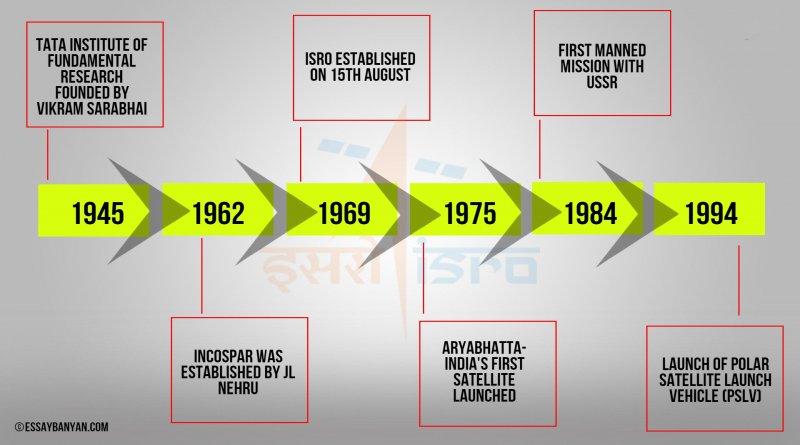
Role of ISRO in the Advancement of India
ISRO’s role in the Advancement of India cannot be forgotten from Aryabhatta to NavIC. Here are some of the projects that became a landmark and helped India in modernization.
- IRS – the Indian Remote Sensing Satellite (IRS) is a series of Earth observation satellites from India. The IRS line provides remote sensing services and is the largest set of residential remote sensing satellites in use today in the world. They have a wide range of applications which are beneficial for different purposes.
- INSAT – The Indian National Satellite System (INSAT) is the Indian family of communication satellites. The project jointly includes DOS, DOT, MBI and Prasar Bharti. It is a multipurpose geostationary satellite helpful in different needs like telecommunications, broadcasting and research. These satellites have been put to good use by the Indian armed forces. GSAT9 or “SAARC Satellite” is a notable example of communication services to India’s small neighbors.
- GAGAN – GAGAN stands for GPS Aided GEO Augmented Navigation. It is a GPS Satellite Augmentation System working regionally; it has satellite communication and air traffic management plan for the aviation industry ‘civil Aviation. The Indian system SBAS, space Augmentation System.
Achievements of ISRO
India is prideful to have ISRO as it has given us many reasons to feel pride. ISRO has always delivered whenever India wanted to do something, ISRO never failed to surprise us. Be it the cheapest landing on Mars or finding water on Moon, ISRO has done many works. Here are some of the Achievements that ISRO must be proud of.
- Mars Orbital Mission (MOM) – The Mars Orbital Mission or Mangalyan is one of the biggest successes for ISRO. ISRO achieved the target of reaching Mars in the most economical way and became the first space agency to reach mars in the first attempt. The budget was 450 crores which is less than many Hollywood movies making India the 4 th country to reach on Mars. There is a movie made to highlight the landing of Mangalyan naming Mission Mangal.
- 104 satellites in 1 Mission – ISRO in 2017 created history as it launched 104 satellites in 1 goes. ISRO used its Polar Satellite Launch Vehicle to perform this target. Among 104 satellites, 101 were foreign and 3 were Indian.
- Water on Moon – India’s Chandrayan I mission was launched on 14 th November, 2008. It landed on the south pole of the moon and founded hydroxyl absorption lines on the surface. It was later confirmed by NASA, when M 3 sent data on 25 th September, 2009.
Budget Allocations
If an organization is this big that the world praises and hails its works, then it will definitely need a good amount of budget. Indian government never failed to provide that. Although, the Mars Orbital Mission was inexpensive but now the budget is not a big issue. The 8,228 Crore expenditure which was allocated for 2020-21, increased to 13,949 Crore for 2021-22. A new public sector named New Space India Limited (NSIL) got an allocation of Rs 700 crores for the same term.
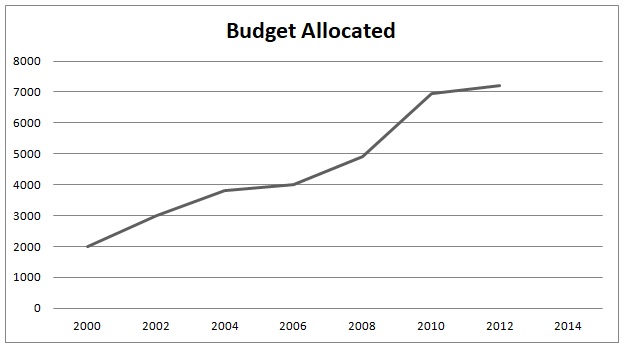
ISRO – The Pride of India
Mentioning ISRO as a pride of India is no doubt a big statement. ISRO is something that India will always boast of. ISRO has been regarded as one of the fastest-growing space agencies in the world and can change the space race. Below mentioned points tell why India considers ISRO a pride.
- ISRO’s mars mission was so cheap that it took only Rs 7/km to reach mars.
- SUPARCO of Pakistan was established 8 years earlier than ISRO but the capabilities of launching satellite will be developed by 2040.
- ISRO is planning to launch Human Spaceflight program in 2023 which might make India the 4 th country to send humans in Space.
- ISRO works closely with Defence Research Development Organization for India’s defence and they have signed an MOU for the upcoming Gaganyan Mission.
- ISRO is also planning to launch its Space Station soon after the Gaganyan mission.
ISRO has always stunned everyone with its unbelievable achievements. However, they have failed many times but it didn’t affect them. ISRO has always learned from the setbacks and just as the diamond shines, it kept shining. The Indian government has also supported ISRO and past few years, the budget allocations are majorly focused. An Indian person sees ISRO scientists as supermen and respects them whenever they get to meet them. ISRO is supposed to compete with NASA in near future and it can be a matter of respect for all of us.
FAQs: Frequently Asked Questions
Ans. ISRO is the National Space Agency which mainly focuses on space affairs in India.
Ans. ISRO stands for Indian Space Research Organization.
Ans. ISRO was established on 15th August 1969.
Ans. The chairman of ISRO is Dr. K. Sivan.
Related Posts
Essay on digital india, cashless india essay, essay on child is father of the man, essay on causes, effects and prevention of corona virus, essay on dr. sarvepalli radhakrishnan, durga puja essay, essay on summer vacation, essay on my plans for summer vacation, essay on holiday.
Essay On Isro
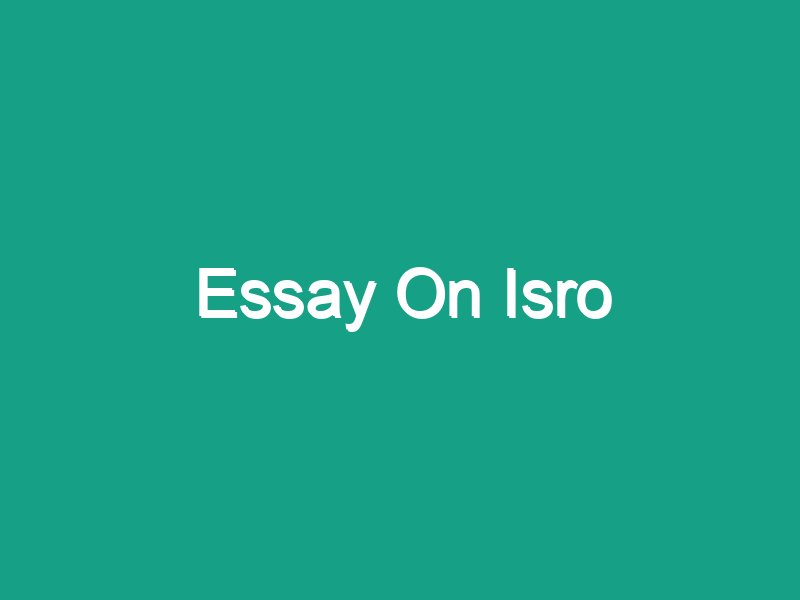
Table of Contents
Short Essay On Isro
The Indian Space Research Organization (ISRO) is the national space agency of India, established in 1969. It is responsible for developing and promoting space technology and its applications for the benefit of the country. Over the years, ISRO has made significant contributions to the field of space exploration and has become one of the leading space agencies in the world.
One of ISRO’s most notable achievements is the successful launch of the Mars Orbiter Mission (MOM), also known as Mangalyaan, in 2014. This was India’s first interplanetary mission and marked a major milestone in the country’s space program. ISRO has also made significant contributions in the field of satellite technology, with the successful launches of satellites for communication, navigation, remote sensing, and meteorology.
In addition to its scientific and technological achievements, ISRO has also made significant contributions to the development of the country. Through the use of satellite technology, ISRO has helped to improve the delivery of essential services, such as telecommunications, education, and healthcare, to remote and rural areas of the country. The organization has also played a major role in the development of India’s satellite-based navigation system, the Indian Regional Navigation Satellite System (IRNSS), which provides precise navigation and location information to users in India and the surrounding region.
ISRO has also been active in international cooperation and collaboration, working with space agencies from around the world to further the development of space technology and its applications. The organization has also played a significant role in the development of the South Asian Association for Regional Cooperation (SAARC) satellite, which will provide communication and disaster management support to the countries of the region.
In conclusion, the Indian Space Research Organization (ISRO) has made significant contributions to the field of space exploration and has become one of the leading space agencies in the world. Through its achievements, ISRO has helped to further the development of the country and has played an important role in international cooperation and collaboration. The organization continues to work towards its mission of advancing space technology and its applications for the benefit of the country and the world.
Long Essay On Isro
India’s space organization, the Indian Space Research Organization (ISRO), has made many remarkable achievements in its 50 years of existence. From the successful launch of Chandrayaan-2 to Mangalyaan, ISRO’s feats have earned it international praise and admiration. In this essay, we’ll explore the history of ISRO, its accomplishments, and what it hopes to achieve in the future.
Introduction to ISRO
The Indian Space Research Organisation (ISRO) is the primary space agency of the Government of India headquartered in the city of Bengaluru. Its vision is to “harness space technology for national development while pursuing space science research and planetary exploration.”
Formed in 1969, ISRO superseded the erstwhile Indian National Committee for Space Research (INCOSPAR) which was established in 1962 by Jawaharlal Nehru. The establishment of ISRO thus institutionalized space activities in India. It is managed by the Department of Space, which reports to the Prime Minister of India.
ISRO built India’s first satellite, Aryabhata, which was launched by a Soviet Union rocket in 1975. Since then, it has launched numerous satellites and robotic missions, including Chandrayaan-1, Mangalyaan and PSLV-C37, which successfully deployed a record 104 satellites in orbit on 15 February 2017. In addition to its scientific pursuits, ISRO also provides launch services for all Indian and some foreign satellites. It has developed two spacecraft launch vehicles: the Polar Satellite Launch Vehicle (PSLV) and Geosynchronous Satellite Launch Vehicle (GSLV), and has operated them from various locations to place over 180 satellites into orbit as of June 2016.
The Vikram Sarabhai Space Centre (VSSC) at Thiruvananthapuram is ISRO’s lead centre for propellant propulsion systems and cryogenic engines;
History and Development of ISRO
The Indian Space Research Organisation (ISRO) is the space agency of the Government of India headquartered in the city of Bengaluru. Its vision is to “harness space technology for national development while pursuing space science research and planetary exploration.”
Formed in 1969, ISRO superseded the erstwhile Indian National Committee for Space Research (INCOSPAR) which was established in 1962 by the efforts of independent India’s first Prime Minister, Jawaharlal Nehru, and his close aide and scientist Vikram Sarabhai. The establishment of ISRO thus institutionalised space activities in India. It is managed by the Department of Space, which reports to the Prime Minister of India.
ISRO built India’s first satellite, Aryabhata, which was launched by a Soviet rocket on 19 April 1975. In 1980, Rohini became the first satellite to be placed in orbit by an Indian-made launch vehicle SLV-3. ISRO subsequently developed two other rockets: the Polar Satellite Launch Vehicle (PSLV) for launching satellites into polar orbits and the Geosynchronous Satellite Launch Vehicle (GSLV) for placing satellites into geostationary orbits. These rockets have launched numerous communications satellites and earth observation satellites. Satellite navigation systems like GAGAN and IRNSS have been deployed in order to augment GPS services over India.
In January 2014, ISRO used an indigenous cryogenic engine in a GSLV-D5 rocket launch to successfully place the GSAT-14 satellite into geostationary orbit. With this, India became the fourth nation in the world to develop such an engine. ISRO sent a lunar orbiter, Chandrayaan-1, on 22 October 2008 and a Mars orbiter, Mangalyaan on 5 November 2013, which entered Mars orbit on 24 September 2014, making India the first nation to succeed on its maiden attempt to Mars.
On 18 June 2016 ISRO set a record with its launch of twenty satellites in a single payload, one being a Cartosat-2 series earth observation satellite. On 15 February 2017 ISRO launched 104 satellites in a single rocket (PSLV-C37) and created history by becoming the first space agency to successfully launch over 100 satellites in one mission. In 2018 it was awarded the International Astronautical Federation’s 2018 Space Pioneer Award in recognition of its contribution to the development of space science and technology.
The journey of ISRO has been marked by numerous achievements since 1969 and it continues to be an inspiration for aspiring scientists and engineers around the world.
Achievements of ISRO
ISRO has made many achievements in the field of space technology and exploration. Some of these achievements are listed below:
1. ISRO launched its first satellite, Aryabhata, in 1975. This was followed by the launch of Bhaskara-I and II in 1979 and 1981 respectively.
2. ISRO developed India’s first cryogenic engine and successfully tested it in 2007.
3. In 2008, ISRO launched Chandrayaan-1, India’s first mission to explore the moon. The mission was successful in mapping the lunar surface and discovering water on the moon.
4. In 2013, ISRO launched Mangalyaan, India’s first mission to Mars. The mission was successful in orbiting Mars and studying its surface features.
5. In 2016, ISRO launched 104 satellites in a single mission, setting a world record for the most satellites launched at one time.
Challenges Faced by ISRO
Since its establishment in 1969, the Indian Space Research Organisation (ISRO) has been at the forefront of space exploration and scientific innovation in India. ISRO has made significant contributions to the development of India’s space infrastructure and capabilities, and has been instrumental in putting India on the map as a major player in the global space arena.
However, ISRO faces many challenges in its quest to maintain its leadership position in the space race. Firstly, ISRO is up against well-established space agencies such as NASA and ESA, which have much greater resources at their disposal. Secondly, ISRO also has to contend with the rapidly emerging Chinese space program, which is making significant strides in both rocket technology and manned spaceflight.
In addition to these external challenges, ISRO also faces internal challenges such as a lack of adequate funding and political support. The Indian government is often reluctant to invest more money in ISRO’s programs, preferring to allocate funds to other areas such as education and healthcare. This means that ISRO has to make do with a limited budget, which hampers its ability to develop new technologies and expand its operations.
Despite these challenges, ISRO has continued to make progress towards its goals. In recent years, it has launched several successful missions including the Mars Orbiter Mission and Chandrayaan-1, and is currently working on developing a reusable launch vehicle and human spaceflight program. With continued effort and dedication, ISRO will no doubt continue to make a significant contribution to India’s space program.
Role of Technology in the Progress of ISRO
Technology has played a vital role in the progress of ISRO. It has helped ISRO to develop a strong infrastructure and also to acquire new capabilities.
ISRO has been able to develop sophisticated technologies for its space programs. These include launch vehicles, satellites, ground stations, and other associated systems. ISRO has also developed indigenous cryogenic engines for its GSLV Mark III launch vehicle. This is a significant achievement as it reduces dependence on foreign suppliers.
The development of these technologies has enabled ISRO to undertake complex space missions such as the Mars Orbiter Mission and the Chandrayaan-1 mission. The successful completion of these missions has enhanced India’s prestige in the international arena.
ISRO’s success would not have been possible without the support of technology. Technology has helped ISRO to reduce costs, increase efficiency, and undertake challenging space missions.
How Does ISRO Impact Indian Society?
The Indian Space Research Organisation (ISRO) is a space agency of the Government of India headquartered in the city of Bengaluru. Its primary mandate is to develop space technology and its application to national development.
Since its inception, ISRO has made significant contributions to India’s socio-economic development. Some of the key ways in which it has impacted Indian society are as follows:
1. ISRO has helped boost India’s self-reliance and technological capability.
2. It has contributed to India’s economic growth by creating employment opportunities and generating wealth through commercialisation of its space products and services.
3. ISRO’s space applications have benefited various sectors of Indian society such as agriculture, communications, disaster management, etc.
4. ISRO has also enhanced India’s international image and stature by undertaking ambitious space exploration missions like Mars Orbiter Mission, Chandrayaan-1, etc.
Future Plans and Vision of ISRO
ISRO plans to continue its strong focus on research and development in order to maintain its leading position in the space industry. The organisation also plans to continue expanding its operations, with a focus on increasing its international presence. In addition, ISRO intends to continue playing a major role in the development of India’s infrastructure and economy.
India has come a long way in the space sector, and ISRO is an integral part of that success. By continuing to work hard and reach for the stars, ISRO will continue to make India proud. The future looks bright for Indian space exploration, with ambitious plans from ISRO that promise to push boundaries further than ever before. We look forward to many more successes from this incredible organization in years to come.

Manisha Dubey Jha is a skilled educational content writer with 5 years of experience. Specializing in essays and paragraphs, she’s dedicated to crafting engaging and informative content that enriches learning experiences.
Related Posts
Essay on importance of yoga, essay on cow, climate change essay, essay on slaver, leave a comment cancel reply.
Your email address will not be published. Required fields are marked *
Save my name, email, and website in this browser for the next time I comment.
"Advertisement"
Essay On ISRO In English For SSC CGL In 500+ Words | ISRO Essay
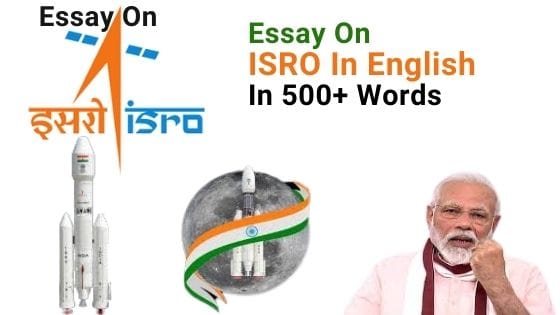
Hello Friends, In this post “Essay On ISRO In English For SSC CGL In 500+ Words | ISRO Essay “. We will read about ISRO with its History, Achievement, and Vision as an Essay in detail.
Note:- this “ Essay on ISRO In English ” is based on the summary of the whole ISRO journey in 500+ Words … It’s helpful for all students.
Let’s Start…
Introduction
India has now become a superpower in the field of space , the journey started by bicycle has now reached Mars , even the journey was not easy. The Indian Space Research Organization (ISRO) was established in 1969 by the government of India .
When the country became Independent in 1947 , we had many challenges, at that time in the field of space science , we were far behind. Neither we had the basic facilities nor the economic conditions were such that we could achieve any stage in this direction at a rapid pace.
The aim of ISRO is to develop and enhance space technology and expand its applications for the benefit of the nation.
Aryabhata , the first satellite made in the country, was launched on 19 April 1975 with the help of Russia , Rohini was the first satellite launched by India . this mission established the foundation that has made India a space superpower today.
- Essay On 5G Technology (Fifth Generation Technology) In 1000+ Words
- Essay On National Educ ation Policy 2020
Body (Essay on ISRO In English)
ISRO has worked on various missions to provide space-based services like weather forecasting, communication broadcasting, etc . to the nation. they also developed technology for their indigenous development .
To accomplish the objective, it was necessary to develop a fully self-reliant, effective, and reliable system that could place satellites in orbit.
Satellite launch vehicles and Augmented satellite launch vehicles were developed by ISRO in the early stages of development of the launch system but did not prove to be as effective.
In such a situation, the third generation launch vehicle PSLV emerged as a reliable carrier. Due to reliability and low cost, it became the most preferred carrier for launching satellites for all different countries.
Therefore, it is also called the work-horse of ISRO . It has launched satellites for important missions such as Chandrayaan-I, Mars Orbiter Mission, and Indian Regional Navigation Satellite System, etc .
On 15 February 2017, ISRO created history by successfully launching 104 satellites on a single rocket from the spaceport in Sriharikota . This spectacular achievement established India as the preferred country to facilitate the launch of satellites in the space market.
PSLV is a four-stage rocket , in which solid fuel is used in the first and third stages and liquid fuel in the second and fourth stages.
Despite its major achievements, PSLV has its limitations, in fact, it can install satellites up to 1750 kg in Low Earth Arbit (Polar Earth) . And can place 1425 kg satellites in sub-geo-synchronous transfer orbit .
But it is unable to place satellites heavier than 2 tonnes in Geosynchronous Transfer Orbit and Geosynchronous Arbit .
Because of this, India had to depend on foreign launch vehicles for the launch of heavy satellites. In which the cost was high, in order to become self-reliant in the launch of heavy satellites and space missions , ISRO developed a three-stage geosynchronous launch vehicle . Under this, ISRO developed GSLV Mark-II , the largest launch vehicle developed by India, which is currently in operation.
- Essay On Privatization Of Indian Railways In 1000+ Words
- Essay On Bird Flu In English 500 Word | History, Symptoms & Prevention
The GSLV Mark II was developed to place up to 2.5 tonnes of Indian National Satellite system -class communications satellites in geosynchronous transfer orbit.
ISRO also has another ambitious project called Reusable launch vehicle . Its purpose is to bring the launch vehicle back to Earth after installing satellites in space so that it can be used again and again.
ISRO’s intention behind this is that the cost of space launch should be reduced and it can also be used in humanitarian missions. Apart from these launch vehicles, ISRO is also developing the Air Breeding Propulsion System “Scramjet Engine” .
It uses hydrogen as fuel and oxygen from the atmosphere as an oxidizer. With its successful testing by ISRO in August 2016, India became the fourth country to test flight of “Scramjet Engine” . This mission will prove to be a milestone for ISRO’s future space transport system.
The first objective of any country’s space agency is to contribute to the development of the nation through space technology .
In such a situation, when we look at the various space programs of ISRO in the last few decades, it shows that they were all focused on national imperatives, under which the emphasis is on the economic and social welfare of the society.
These space programs focus on the Management of resources such as Earth Observation , Forest Mapping, Water Bodies Mapping, Weather Forecasting, Disaster Management, Agricultural Water and Fisheries, etc . Apart from these, services like telemedicine, Tele-education are being provided at the rural level through satellite.
- Essay On Self-Reliant India Mission In English
- Essay On Water Crisis In India
Conclusion (Essay on ISRO In English)
ISRO is on par with leading space research organizations in the world , including NASA of the United States , CNSA , and the European Space Agency, ESA .
The dedicated and diligent scientists are giving a new direction to ISRO . and ISRO will soon become a leading space organization in the world with the most efficient and economical services .
If you have any query related to “ Essay On ISRO In English For SSC CGL In 500+ Words | ISRO Essay “, please comment.
Thanks For Reading “ Essay On ISRO In English For SSC CGL In 500+ Words | ISRO Essay ”
- Essay On Ayushman Bharat Yojana
- Essay On One Nation One Ration Car d | Advantage & Disadvantage
Leave a Comment Cancel reply
Save my name, email, and website in this browser for the next time I comment.

25,000+ students realised their study abroad dream with us. Take the first step today
Meet top uk universities from the comfort of your home, here’s your new year gift, one app for all your, study abroad needs, start your journey, track your progress, grow with the community and so much more.

Verification Code
An OTP has been sent to your registered mobile no. Please verify

Thanks for your comment !
Our team will review it before it's shown to our readers.

- School Education /
Essay on Chandrayaan 3 🧑🚀: Timeline, Successful Landing
- Updated on
- Mar 15, 2024

To mark the successful landing of the Chandryaan-3 on the lunar surface, the Indian Prime Minister, Shri Narendra Modi , announced that 23rd August will be annually celebrated as National Space Day.
This article will cover some samples of essay on Chandryaan-3. Chandrayaan-3 was the first Indian spacecraft to successfully land on the south pole of the lunar surface. It was launched on 14th July 2023 by the Indian Space Research Organisation (ISRO) from its Satish Dhawan Space Centre (SDSC)-SHAR in Sriharikota , Andhra Pradesh. On 23rd August at 18:03 IST, the lander ‘ Vikram ‘ touched down on the lunar south pole. This showed India’s capability of safely landing on the lunar surface, thus making it the first country to step on a lunar-south pole through Chandrayaan 3 .
Master the art of essay writing with our blog on How to Write an Essay in English .
This Blog Includes:
Essay on chandrayaan-3 in 100 words, essay on chandrayaan 3 in english 150 words, essay on chandrayaan 3 in 200 words, timeline of chandryaan 3, points about chandrayaan-3.
Also Read: Essay on Peer Pressure: 100, 200 and 450 Word Samples in English
The first lunar exploration mission in the history of ISRO was Chandrayan. It was launched in the year 2008 and since then 2 more follow missions have been launched under this program.
The second follow-up mission was launched in 2019 and followed by a third follow-up mission in 2023. The success of Chandrayaan 3 has marked the country in different records such as the first country to land on the moon’s south pole and the most cost-effective execution.
It was launched on July 14, 2023, from Sriharikota’s SDSC SHAR and landed successfully on 23rd August 2023. The mission will be carried down for 14 Earth days i.e. the Rover on the ladder will roam around the moon and study its surface for 14 days. This successful attempt has made India very sure of further development and planned missions for the Moon.
Chandrayaan-3 is India’s ambitious space mission which has made India proud. It was a successful space mission aimed to conduct a soft landing at the lunar south pole of the moon through the Vikram Lander. The spacecraft is also equipped with a Rover Pragyan consisting of payloads to study the moon’s surface. Apart from this, there were 9 sensors in the Lander.
Talking about the Payloads, there were 4 payloads in the lander namely ChaSTE, ILSA, RAMBHA, and LRA. 2 Rover payloads were APXS and LIBS. The propulsion module also contains a payload i.e. SHAPE. These payloads are designed to study the moon’s surface.
Chandrayaan-3 was active for 14 Earth days in the presence of the sun. After which, the Lander and the Rover were kept to sleep on 2 September because they could not function in the absence of sunlight. Later, efforts were made to wake Lander and Rover when the sunlight hit the moon’s surface. But ISRO revealed that there were no signals from the Lander and Rover.
Despite this, the project was a successful one and it has marked the name of India in Golden words in the history of Space.
Hon’ble Prime Minister of India has named the landing spot of Chandrayaan-3 as Shiv Shakti Point.
Chandrayaan-3 is the most successful follow-up mission in the history of Indian space missions. It was followed by the successful Chandrayaan 1 and partly successful Chandrayaan 2. It has made a successful soft landing on the lunar surface and made India the fourth country to land on the lunar surface.
It also marked India as the first country to land on the Moon’s south pole. It examined the presence of water and also gathered some valuable scientific information and data about its mineral composition and its geology.
One of the main objections to this lunar mission was to make a soft landing. The Rover ‘Pragyan” will roam on the lunar surface for 1 Lunar day (Around 14 Earth Days).
The cost of Chandrayaan 3 is much less than the previous attempt which is around INR 615 Crores making it the most cost-effective lunar mission.
On 7th September 2019, ISRO’s Chandryaan 2 crashed while attempting a soft landing on the lunar surface. Since then, the Indian Space Research Organisation decided to build a successor to the Chandrayaan 2.
- 06 July 2023 – Chandryaan 3 is scheduled to launch on July 14, 2023, at 14:35 Hrs. IST from the Second Launch Pad, SDSC-SHAR, Sriharikota.
- 07 July 2023 – Vehicle electrical tests completed.
- 11 July 2023 – The ‘Launch Rehearsal’ simulation the launch preparation and process lasting 24 hours was concluded.
- 14 July 2023 – LVM3 M4 vehicle successfully launched Chandrayaan-3 into orbit. Chandrayaan-3, in its precise orbit, started its journey to the Moon.
- 15 July 2023 – The first orbit-raising manoeuvre was performed at ISTRAC/ISRO, Bengaluru. The spacecraft was in 41762 km x 173 km orbit.
- 17 July 2023 – The second orbit-raising manoeuvre was performed. The spacecraft was in 41603 km x 226 km orbit.
- 25 July 2023 – The last orbit-raising manoeuvre was performed.
- 01 August 2023 – The spacecraft entered the translunar orbit.
- 05 August 2023 – Chandrayaan-3 was successfully inserted into the lunar orbit.
- 14 August 2023 – The mission was in the orbit circularisation phase.
- 17 August 2023 – The Lander Module was successfully separated from the Propulsion Module.
- 23 August 2023 – Chandrayaan-3 successfully reached its destination Chandrayaan-3 completed soft-landed on the moon. Congratulations, India!
Chandrayaan-3 Mission: Vikram Lander is set into sleep mode around 08:00 Hrs. IST today. Prior to that, in-situ experiments by ChaSTE, RAMBHA-LP and ILSA payloads are performed at the new location. The data collected is received at the Earth. Payloads are now switched off.… pic.twitter.com/vwOWLcbm6P — ISRO (@isro) September 4, 2023
To improve your essay writing skills, here are the top 200+ English Essay Topics for school students.
Chandrayaan-3's triumph mirrors the aspirations and capabilities of 140 crore Indians. To new horizons and beyond! Proud moment for 🇮🇳. https://t.co/4oi6w7TCGG — Narendra Modi (@narendramodi) August 23, 2023
Read More About Chandryaan 3
About Chandrayaan Project
The Chandrayaan Project is one of the most successful projects in the history of India’s space agency. It was launched by ISRO for the exploration of the lunar surface.
The first mission i.e. Chandrayaan-1 was launched on 22 October 2008. It was a successful mission and was inserted into the lunar orbit on 8th November 2008. It marked a new success for the country and India became the fifth country in world history to reach the lunar surface. The cost of this mission was around 386 crores a lot less than any other space agency. The most prominent discovery of this mission was the presence of water molecules in the lunar south pole. It stopped communication with the base on 28 August 2009 and was declared over.
Chandrayaan-2 was followed by a second mission that was launched on 22 July 2019. It was successfully inserted into the lunar orbit on 20 August 2019 but failed to make a soft landing on the lunar surface on 6th September 2019 just 2.1 km away from the surface. However, it was declared partly successful because the orbiter was still functional for around 7.5 years.
Chandrayaan-3 Mission: The Rover completed its assignments. It is now safely parked and set into Sleep mode. APXS and LIBS payloads are turned off. Data from these payloads is transmitted to the Earth via the Lander. Currently, the battery is fully charged. The solar panel is… — ISRO (@isro) September 2, 2023
Another successful lunar landing attempt was made recently in the year 2023 and was launched on 14 July 2023. It completed its landing and the lander “Vikram Lander” and Rover “Pragyan” landed on the lunar south pole on 23rd August 2023.
The main aim of this mission is the same as the Chandrayaan 2 to study the atmosphere of the moon and also explore its mineral composition. It will also further explore the presence of water in the lunar surface. The cost of this follow-up mission is around INR 615 crores making it one of the most cost-effective lunar missions.
Read all of our other popular essays
The first mission of Chandrayaan i.e. Chandrayaan 1 was launched in 2008. It was followed by Chandrayaan 2 and Chandrayaan-3 in 2019 and 2023 respectively. The latest version of Chandrayaan was a successful attempt to make India the first country to land safely on the Moon’s South Pole region.
The successful attempt of Chandrayaan 3 made India the first country to land on the moon in its south pole region.
The cost of Chandrayaan 3 is approximately 615 crores ($75 million). It is the most affordable and successful mission to land on moon in the history.
Chandrayaan-3 was a successful mission by the Indian Space Research Organization. It has demonstrated a soft landing on the unexplored lunar south pole of the moon and conducted in-situ research. It was launched on 14 July 2023 and landed on 23 August 2023.
Hence, we hope that this blog has assisted you in comprehending what an essay on Chandrayaan 3 must include. For more information on such interesting topics, visit our essay writing page and follow Leverage Edu .
Simran Popli
An avid writer and a creative person. With an experience of 1.5 years content writing, Simran has worked with different areas. From medical to working in a marketing agency with different clients to Ed-tech company, the journey has been diverse. Creative, vivacious and patient are the words that describe her personality.
Leave a Reply Cancel reply
Save my name, email, and website in this browser for the next time I comment.
Contact no. *

Connect With Us

25,000+ students realised their study abroad dream with us. Take the first step today.

Resend OTP in

Need help with?
Study abroad.
UK, Canada, US & More
IELTS, GRE, GMAT & More
Scholarship, Loans & Forex
Country Preference
New Zealand
Which English test are you planning to take?
Which academic test are you planning to take.
Not Sure yet
When are you planning to take the exam?
Already booked my exam slot
Within 2 Months
Want to learn about the test
Which Degree do you wish to pursue?
When do you want to start studying abroad.
January 2024
September 2024
What is your budget to study abroad?

How would you describe this article ?
Please rate this article
We would like to hear more.
Have something on your mind?

Make your study abroad dream a reality in January 2022 with
India's Biggest Virtual University Fair

Essex Direct Admission Day
Why attend .

Don't Miss Out

Essay on India in Space
Students are often asked to write an essay on India in Space in their schools and colleges. And if you’re also looking for the same, we have created 100-word, 250-word, and 500-word essays on the topic.
Let’s take a look…
100 Words Essay on India in Space
Introduction.
India’s journey in space research began in 1962 with the Indian National Committee for Space Research. Its mission: to use space technology for national development.
ISRO’s Formation
The Indian Space Research Organisation (ISRO) was formed in 1969. It developed India’s first satellite, Aryabhata, launched by the Soviet Union in 1975.
Moon and Mars Missions
India made history with the Chandrayaan-1 in 2008, discovering water on the moon. In 2014, the Mars Orbiter Mission made India the first Asian nation to reach Mars orbit.
Future Plans
ISRO plans to explore Venus and the Sun’s corona, demonstrating India’s growing prowess in space.
250 Words Essay on India in Space
Introduction to india’s space journey.
India’s foray into space research and exploration has been a testament to its scientific prowess and determination. Initiated in 1962 with the formation of the Indian National Committee for Space Research (INCOSPAR), it has grown into a full-fledged space agency, the Indian Space Research Organisation (ISRO).
Major Milestones in India’s Space Exploration
India’s journey in space exploration has been marked by significant milestones. The launch of the first satellite, Aryabhata, in 1975 marked the beginning of India’s independent space journey. However, the launch of Chandrayaan-1 in 2008, which discovered water molecules on the moon, and the Mars Orbiter Mission (MOM) in 2013, which made India the first Asian country to reach Martian orbit, are testaments to the country’s advanced scientific capabilities.
Current Endeavours and Future Prospects
Currently, India is working on several ambitious projects. Gaganyaan, India’s first manned space mission, aims to send astronauts into space by 2022. The Aditya-L1 mission, set for 2022, intends to study the Sun’s corona.
India’s space journey is not only about exploring the cosmos but also about leveraging space technology for societal benefits. With advancements in communication satellites, remote sensing, and satellite navigation, India is using space technology for disaster management, weather forecasting, telemedicine, and education.
India’s space journey has been a blend of scientific curiosity, national pride, and societal development. With its future missions, India is set to further its reputation as a major player in global space research and exploration. The journey of India in space is a testament to the power of a vision, scientific rigor, and indomitable determination.
500 Words Essay on India in Space
India’s journey into space is a fascinating narrative of ambition, determination, and scientific advancement. The Indian Space Research Organisation (ISRO), established in 1969, has been the driving force behind India’s space exploration, transforming the nation from a developing country to a significant player in the global space community.
ISRO’s Early Years and Achievements
ISRO’s initial years were marked by resource constraints and technological limitations. Despite these challenges, the organization launched its first satellite, Aryabhata, in 1975, marking a significant milestone in India’s space journey. The Satellite Instructional Television Experiment (SITE) in 1975-76, which brought educational programs to rural areas, and the Indian National Satellite (INSAT) system, launched in 1983 for telecommunication and broadcasting services, showcased the potential of space technology for societal benefits.
Technological Advancements and Mars Mission
ISRO’s technological prowess increased over the decades, culminating in the successful launch of the Mars Orbiter Mission (MOM), also known as Mangalyaan, in 2013. This mission made India the first Asian country to reach Mars and the first in the world to do so on its maiden attempt. The mission was not merely a demonstration of India’s technological capabilities, but it also contributed to the global understanding of Mars, with findings about the planet’s atmosphere and surface.
Chandrayaan Missions and Lunar Exploration
India’s lunar exploration program, Chandrayaan, has also received international acclaim. Chandrayaan-1, launched in 2008, made a significant discovery of water molecules on the lunar surface. Chandrayaan-2, despite a setback in the soft landing attempt, has provided valuable data about the lunar surface and will pave the way for future missions.
The Commercial Aspect: Antrix Corporation
Recognizing the commercial potential of space technology, ISRO established Antrix Corporation in 1992. Antrix has successfully commercialized ISRO’s capabilities in satellite technology and launch services, providing cost-effective solutions to international clients and contributing to the global space economy.
Future Prospects: Gaganyaan and Beyond
ISRO’s future plans include the ambitious Gaganyaan mission, which aims to send Indian astronauts to space by 2022. This mission will significantly enhance India’s position in the global space community. Furthermore, ISRO’s plans for exploring Venus and the Sun’s corona indicate that India’s space journey is far from over.
India’s space journey represents a blend of scientific curiosity, technological prowess, and a vision for societal development. It is a testament to the nation’s capabilities and potential. As India continues to explore the vast expanse of space, it not only contributes to global scientific knowledge but also inspires future generations to dream big and strive for excellence.
That’s it! I hope the essay helped you.
If you’re looking for more, here are essays on other interesting topics:
- Essay on Space Shuttle
- Essay on Space
- Essay on A Day in Space
Apart from these, you can look at all the essays by clicking here .
Happy studying!
Leave a Reply Cancel reply
Your email address will not be published. Required fields are marked *
Save my name, email, and website in this browser for the next time I comment.
Essay on ISRO
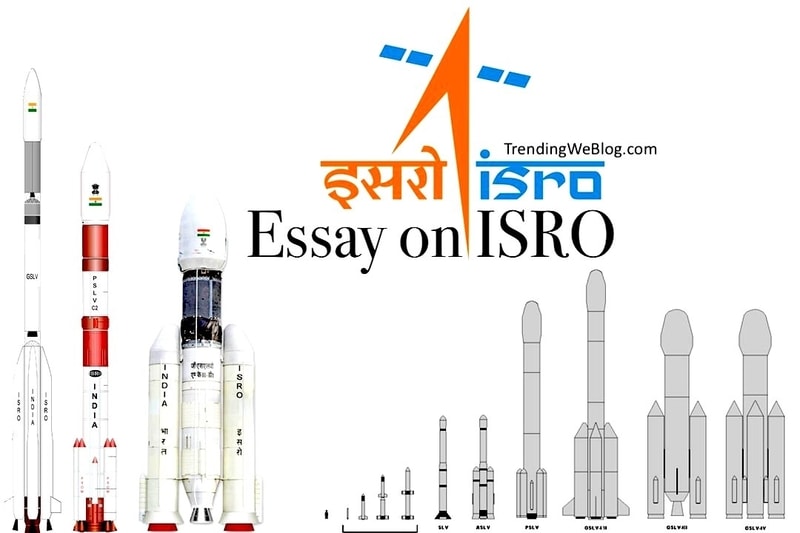
ISRO essay for Class 1, 2, 3, 4, 5, 6, 7, 8, 9, 10, 11, 12 and College students. Find a paragraph, long and short essay on essay on ISRO for Students.
Essay on ISRO 250 Words
The Indian Space Research Organization (ISRO) was established in 1969 by the government of India. It is headquartered in Bangalore and is under the umbrella of the Department of Space. Modern space program received an impetus with the leadership of Dr Vikarm Sarabhai. The aim of ISRO is to develop and enhance space technology and expand its applications for the benefit of the nation. Achieved a number of milestones since its establishment.
ISRO launched its first satellite Aryabhata, Rohini in India. In 2008, PSLV rockets managed to launch Chandrayaan-1 into Moon. Mars Orbiter Mission in 2014. ISRO achieved the success in navigation satellite systems. GAGAN and IRNSS have been deployed. ISRO created the history by successfully launching 104 satellites on a single rocket from the spaceport in Sriharikota. It is also very important for military upgradation under constant threat from our neighbours.
ISRO has applied its technology for the benefit of mankind in telemedicine, remote sensing, weather forecast, farming, geological mapping and survey, satellite communication controlling deforestation, disaster management and security purpose. It also faces some challenges like sufficient funding, development of GSLV satellites and solar shielding of satellites.
ISRO is on par with leading space research organizations in the world, including NASA of the United States, CNSA and the European Space Agency, ESA. The dedicated and diligent scientists are giving a new direction to ISRO. ISRO has made its mark in space technology with latest satellite launches and development of state of the art engines. It will soon become a leading space organization in the world with the most efficient and economical services.
We hope you like our Essay on ISRO.
You may also like
10 tips to write an essay for esl students.

Christmas Essay

Essay on Guru Nanak Dev Ji

Save Water Essay

Visit to Zoo Essay in English

Raksha Bandhan Essay
About the author.
Leave a Comment X
Covering the business and politics of space
ESA and ISRO explore increased cooperation

- Click to share on X (Opens in new window)
- Click to share on Facebook (Opens in new window)
- Click to share on LinkedIn (Opens in new window)
- Click to share on Reddit (Opens in new window)
- Click to email a link to a friend (Opens in new window)
- Click to share on Clipboard (Opens in new window)

WASHINGTON — The European Space Agency, impressed with India’s growing space capabilities, is exploring opportunities for enhanced cooperation in space activities.
At a March 27 media briefing after a meeting of the ESA Council, Renato Krpoun, chair of the council, said that ESA members received a presentation during the meeting from S. Somanath, chairman of the Indian Space Research Organisation (ISRO).
Somanath “presented a very impressive vision of the future of the Indian space program,” Krpoun said.
Josef Aschbacher, director general of ESA, said later in the briefing that Somanath’s presentation provided an update on recent activities by ISRO. “It has opened our eyes, first of all, to what is happening in India,” he said.
What India is accomplishing in space – especially in Lunar exploration – is astonishing. We hosted @isro 's Chairman, Dr. S. Somanath at ESA Council today. It was a milestone occasion for Delegates to learn more about current and future plans for ESA-ISRO cooperation. The… pic.twitter.com/tvCiWj08TL — Josef Aschbacher (@AschbacherJosef) March 27, 2024
He said that in late 2022, he discussed with Somanath how the two agencies could “intensify their cooperation on a number of domains” in space activities. “We agreed this is something that we should investigate further.”
That investigation has included a week-long visit by an ESA delegation to India to discuss options in science, exploration and operations. “At the moment we are in a fact-finding mission,” he said. He didn’t elaborate on specific cooperative missions or programs being considered or their schedules, other than that any plans that do advance and require funding from ESA member states would be included in the package of proposals for the next ministerial conference in late 2025.
“This is an ongoing exercise, but certainly the spirit is very positive,” he concluded. “There is an interest on both sides to intensify the cooperation, which already has been excellent, but to increase it and enlarge it a bit.”
There is cooperation between the two agencies today, although at a relatively low level. A July 2021 agreement gave ISRO access to ESA ground stations for some of its missions, like the Chandrayaan-3 lunar lander and Aditya-L1 solar science spacecraft, in exchange for ESA access to ISRO tracking stations for some missions. ISRO has also cooperated directly with some ESA member states, notably France on a series of Earth science missions.
India is also increasing its cooperation with the United States in space . India joined the Artemis Accords in June 2023 and the governments of the two nations said at the time they would develop a “a strategic framework for human spaceflight cooperation” that could include flying an Indian astronaut to the International Space Station.
In progress developments
The ESA Council meeting also discussed several other topics, but with few new developments. ESA confirmed that the first launch of the Ariane 6 remains scheduled for between the middle of June and the end of July. Aschbacher said a more precise launch date should come in late April, after the completion of a qualification review.
ESA remains on track to make selections for a new commercial cargo program at the next Space Summit, scheduled for May 23 in Brussels. The agency expects to select up to three companies for “phase one” study contracts, with phase two awards to develop the spacecraft to come after funding is secured at the 2025 ministerial conference.
ESA is also closely watching NASA’s ongoing reassessment of the Mars Sample Return (MSR) mission architecture. ESA is a partner on MSR, providing the Earth Return Orbiter and a robotic arm to transfer samples from the Perseverance rover to the lander that will launch them into orbit. That reassessment, prompted by an independent review last fall that concluded MSR was significantly over budget and behind schedule , is expected to be published as soon as April.
“We are in constant dialogue with NASA” on MSR, Aschbacher said. “The dialogue is extremely good and positive and constructive; very transparent.”
“We are very committed to deliver our components on time and on schedule,” he added.
Jeff Foust writes about space policy, commercial space, and related topics for SpaceNews. He earned a Ph.D. in planetary sciences from the Massachusetts Institute of Technology and a bachelor’s degree with honors in geophysics and planetary science... More by Jeff Foust

Sign up for a SpaceNews newsletter
Get top stories, military space news and more delivered to your inbox.
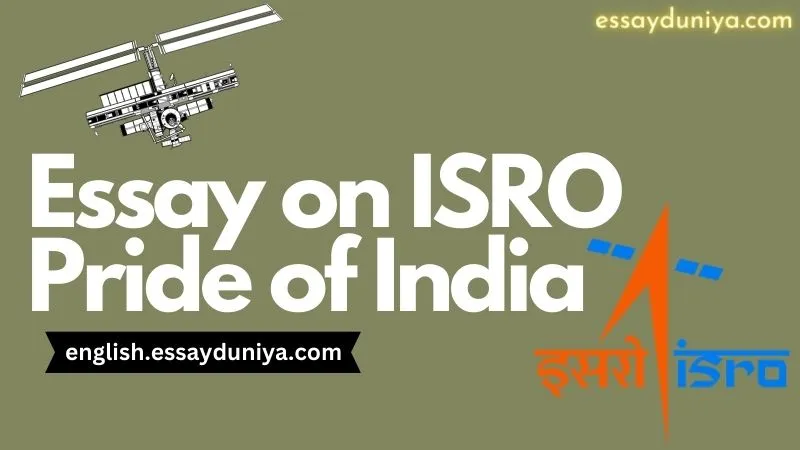
Essay on ISRO Pride of India
Are you also looking for an “Essay on ISRO Pride of India”? If yes, then you have fallen on the world’s best website essayduniya.com. If you are searching for Essay on ISRO Pride of India, ISRO essay 250 words, Essay on ISRO in 200 words, a Paragraph on ISRO in English , India’s achievements in space Essay in English, Indian Space Mission Essay Then your wait ends here.
Essay on ISRO Pride of India 150 Words
The Indian Space Research Organisation (ISRO) is the government of India’s space agency and is in charge of space exploration and research. ISRO, which was founded in 1969, has become one of the world’s most successful space organizations and continues to be a major source of national pride. The various accomplishments and contributions of ISRO will be emphasized in this essay, demonstrating why it is rightly regarded as the pride of India.
The Indian Space Research Organisation (ISRO) is a proud representation of India’s technological and scientific prowess. From its humble beginnings to its ground-breaking successes in satellite launches and space exploration, ISRO has left its mark on the world stage. Its commitment to utilizing space technology for societal advantages raises the significance of what it does. Future generations of scientists, engineers, and dreamers will undoubtedly be inspired by ISRO as it pushes the boundaries of space research and exploration, advancing India’s space exploration legacy.
Speech on Kargil Vijay Diwas in English Speech on Kargil Vijay Diwas in Hindi Speech on Chandrayaan 3 in English Speech on Chandrayaan 3 in Hindi Chandrayaan 3 Essay in English Essay on Chandrayaan 3 in Hindi
Essay on ISRO in 200 words
Indian Space Research Organisation, or ISRO, is the country’s national space agency, and it is based in Bengaluru. Additionally, the ISRO space agency is under the control of the Indian Government’s Department of Space. In the year 1969, ISRO was established. The creation of ISRO was also motivated by the desire to advance and use space technology for national advancement. Additionally, planetary exploration and space science research were to be pursued at the same time as this development and utilization of space technology.
The Indian National Committee for Space Research, which was founded in 1962, was succeeded by ISRO. Today, ISRO is regarded as one of the top space agencies in the world. Currently, ISRO is the main Indian organization responsible for carrying out tasks connected to the advancement of new technologies, space exploration, and space-based applications. Additionally, ISRO is one of only six government organizations that runs sizable constellations of man-made satellites, uses cryogenic propulsion, launches extraterrestrial missions, and has full launch capabilities.
For many years, the Indian Space Research Organisation has integrated space services for the good of the people and the country. ISRO also oversees the maintenance of one of the biggest fleets of remote sensing and communication satellites. They perform the functions of Earth observation and quick and trustworthy communication.
India’s achievements in space Essay in English
Introduction .
The Indian Space Research Organisation (ISRO) has established itself as a symbol of Indian pride and scientific advancement. Since its founding in 1969, ISRO has developed into a trailblazing space agency that has accomplished incredible feats in satellite technology, scientific research, and space exploration. This essay explores the various facets that make ISRO a driving force behind Indian scientific progress and a source of inspiration for the country.
Affordable Satellite Launches
International acclaim has been won by ISRO’s capacity for affordable satellite launches, particularly through the Polar Satellite Launch Vehicle (PSLV). A variety of satellites, both domestic and foreign, have been launched using the PSLV, further establishing India’s position in the international space market. Antrix Corporation, the organization’s commercial arm, facilitates commercial satellite launches and has been instrumental in generating income and fostering cross-border partnerships.
Social Development Applications
Space technology has been consistently used by ISRO to advance society. ISRO’s applications have improved the lives of millions of Indians, from telemedicine, weather forecasting, and disaster management to remote sensing for agriculture, forestry, and urban planning. It is commendable that the organisation is working to close the digital divide and bring space technology’s advantages to isolated regions.
Mars Orbiter Mission: The Victorious (Mangalyaan)
The Mars Orbiter Mission, also known as “Mangalyaan,” was successfully carried out in 2014, cementing ISRO’s place in space history. The main goals of the mission were to explore Mars and show off India’s interplanetary abilities. The fact that ISRO accomplished this feat on its first try and for a small portion of the cost of missions of a similar nature by other space agencies speaks volumes about the organization’s ingenuity and commitment.
With each accomplishment, ISRO builds on its reputation as a driving force behind Indian scientific progress and a long-lasting source of pride for India, inspiring both the country and the world. The ISRO’s unwavering dedication to scientific excellence and societal welfare promises to shape the future of India’s space exploration and contribute to the improvement of humanity as a whole as the organization looks toward the future with ambitious missions and endeavors.
Indian Space Mission Essay
In Hindi, ISRO is also known as Bhartiya Antariksh Anusandhan Sangathan. The Indian Prime Minister can see it directly. Dr. Kailasavadivoo Sivan, also known as K Sivan, is the current chairman and senior executive for the Department of Space (DOS). The record for having full launch capabilities, the ability to launch extraterrestrial missions, and the capacity to manage a large cortege of artificial satellites belongs to ISRO.
THE ISRO’S HISTORY
S.K. Mitra, C.V. Raman, and Meghnad Saha, among other scientists, carried out space programmes in the past. Physical Research Laboratory was later established in Ahmedabad by Vikram Sarabhai. Tata Institute of Fundamental Research was founded by Homi Bhabha in 1945. Prime Minister Jawaharlal Nehru created INCOSPAR in 1962 in response to the nation’s desire for space research. Thumba Equatorial Rocket Launching Station (TERLS), later in 1963, launched a sounding rocket. ISRO, the Indian Space Research Organisation, was founded on August 15th, 1969.
One of the most significant events occurred when ISRO launched its first satellite, “Aryabhatta,” using a Soviet rocket in 1975. The Indian National Satellite (INSAT-1A) was launched later, in 1982. In 1984, Rakesh Sharma participated in the first manned mission, which was carried out in conjunction with the Soviet Union. The third generation of launch vehicles, the Polar Satellite Launch Vehicle (PSLV), was launched by ISRO in 1994. 2001 saw the successful launch of the GSLV D1 by ISRO. In the years 2008 and 2014, ISRO was successful in landing on Mars.
Budgetary Allotments
An organisation will undoubtedly require a sizable budget if it is this large and the entire world hails and praises its accomplishments. The Indian government has always offered that. Although the Mars Orbital Mission’s budget was modest, this is no longer a major concern. Spending that was budgeted for 2020–21 increased to 13,949 Crore for 2021–22 from 8,228 Crore. 700 crores of rupees were allotted to the brand-new public sector known as New Space India Limited (NSIL) for the same period.
The Pride of India ISRO
It is undoubtedly a bold statement to refer to ISRO as India’s pride. India will forever take pride in its ISRO. One of the world’s most rapidly expanding space agencies, ISRO has the potential to alter the space race. The reasons why India views ISRO as a source of pride are listed below.
The cost of the ISRO Mars mission was so low that it only cost Rs 7/km to travel there. Although Pakistan’s SUPARCO was founded eight years before ISRO, it won’t be able to launch satellites until 2040. In 2023, ISRO intends to launch its Human Spaceflight program, potentially making India the fourth nation to send astronauts into space. For India’s defense, ISRO collaborates closely with the Defence Research and Development Organisation, and they have signed an MOU for the upcoming Gaganyan Mission. Following the Gaganyan mission, ISRO intends to launch the Space Station.
Everybody has always been in awe of ISRO’s incredible accomplishments. They have, however, repeatedly failed, but it hasn’t stopped them. Just like a diamond shines, ISRO has always been able to shine despite setbacks. The budget allocations over the last few years have been heavily focused on ISRO, which the Indian government has also supported. When an Indian meets an ISRO scientist, they regard them as supermen and show them the utmost respect. It could be a matter of respect for all of us if ISRO competes with NASA in the near future.
Do tell us in the comment box how you like “Essay on ISRO Pride of India”? Next, on which topic do you want a speech or an essay, do tell us by commenting! We are waiting for your comments…!
Speech on Kargil Vijay Diwas in English Speech on Kargil Vijay Diwas in Hindi Speech on Chandrayaan 3 in English 10 Lines on Chandrayaan 3 in English Speech on Chandrayaan 3 in Hindi Chandrayaan 3 Essay in English Essay on Chandrayaan 3 in Hindi Chandrayaan-3 Par 10 Lines in Hindi
Leave a Comment Cancel reply
Save my name, email, and website in this browser for the next time I comment.

IMAGES
VIDEO
COMMENTS
Answer 2: Two satellites launched by ISRO are Aryabhata and Rohini. Furthermore, Aryabhata was the first Indian satellite that was built by ISRO. Moreover, Rohini was the first satellite whose placing took place in the orbit by SLV-3. Essay on Balance is Beneficial.
Essay on ISRO: The Indian Space Research Organisation is the national space agency of India. It was founded in 1969 to develop an Indian space program. ISRO operates through a countrywide network of centres. ISRO is the primary agency that performs tasks related to space-based applications. ISRO has launched more than 50 satellites of other countries. […]
500 Words Essay on ISRO Introduction. The Indian Space Research Organisation (ISRO) is a shining beacon of India's technological prowess and innovative spirit. Established on August 15, 1969, ISRO has been at the forefront of space exploration, contributing significantly to scientific knowledge and technological advancements.
ISRO's first satellite, Aryabhata, was launched by the Soviet Union on April 19, 1975. Rohini, the first satellite to be placed in orbit by an Indian-made launch vehicle (the Satellite Launch Vehicle 3), was launched on July 18, 1980. ISRO has launched several space systems, including the Indian National Satellite (INSAT) system for telecommunication, television broadcasting, meteorology ...
This essay will discuss how ISRO has demonstrated its excellence, innovation and leadership in various domains of space technology and exploration, such as satellite technology, launch vehicle technology, lunar missions, interplanetary missions and human spaceflight programme. It will also examine how ISRO has contributed to India's socio ...
Essay on ISRO in English in 10 Lines. "Explore the triumphs and advancements of the Indian Space Research Organization (ISRO) in this concise essay, highlighting its journey, achievements, and impact on space exploration and technology.". The Indian Space Research Organisation (ISRO) is India's premier space agency, founded in 1969.
500 Words Essay on Isro the Pride of India. A true gem in India's crown, ISRO, the Indian Space Research Organisation, elevates India's standing on the global stage. ISRO symbolizes the very spirit of India - innovative, resilient, and forward-looking.
Indian Space Research Organisation, or ISRO, is the country of India's space agency. It was established in 1969 to support the creation of an indigenous space project in India. The Department of Space of the Government of India oversees ISRO, a space agency with headquarters in Bengaluru, Karnataka. Its goal is to pursue planetary exploration ...
The Indian Space Research Organisation (ISRO / ˈ ɪ s r oʊ /) is the national space agency of India. It operates as the primary research and development arm of the Department of Space (DoS), which is directly overseen by the Prime Minister of India while the Chairman of ISRO also acts as the executive of DoS. ISRO is primarily responsible for performing tasks related to space-based ...
ISRO is the abbreviation of Indian Space Research Organisation. It is an intergovernmental organization, founded in 1969 by India's first Prime Minister, Jawaharlal Nehru. The isro achievements is a essay about how India's space agency, the Indian Space Research Organization (ISRO), has been able to achieve success in its endeavors.
Following the triumphant soft landing of Chandrayaan 3 on the lunar south pole last week, the Indian Space Research Organisation (ISRO) is poised for yet another monumental stride. Today, from the Satish Dhawan Space Centre in Sriharikota, ISRO is set to embark on the launch of the Aditya-L1 Mission. This historic mission heralds India's first venture into space-based solar observatories ...
ISRO, Indian Space Research Organisation, is the space agency of the Indian government's Department of Space, based in Bengaluru, Karnataka. It was founded in 1969 and holds the mission to use space technology for national growth while conducting space science research and planetary exploration. ISRO is one of the essential Indian bodies that ...
Space Blog. ISRO (Indian Space Research Organisation) is one of the leading space agencies in the world. Starting from zero, it has come to the fifth rank among the world's top space agencies. It has been almost 60 years since the Indian National Committee for Space Research (INCOSPAR) was established, and later it was given the name Indian ...
In 2013, ISRO achieved a historic feat by successfully launching the Mars Orbiter Mission, or Mangalyaan. India became the fourth space agency in the world to reach Mars, and ISRO did it on its maiden attempt. 4. Chandrayaan - Exploring the Moon. ISRO's Chandrayaan missions have been instrumental in lunar exploration.
ISRO is the space agency under the Department of Space of Government of India, headquartered in the city of Bengaluru, Karnataka. Its vision is to harness space technology for national development, while pursuing space science research and planetary exploration. Antrix Corporation Limited (ACL) is a Marketing arm of ISRO for promotion and ...
Here is a long essay mentioning the history and importance of ISRO to India. 10 Lines Essay on ISRO (100-120 Words) 1) The space-related affairs of India are managed by an agency known as ISRO. 2) ISRO (Indian Space Research Organization) was set up on 15 August 1969.
Short Essay On Isro. The Indian Space Research Organization (ISRO) is the national space agency of India, established in 1969. It is responsible for developing and promoting space technology and its applications for the benefit of the country. Over the years, ISRO has made significant contributions to the field of space exploration and has ...
Body (Essay on ISRO In English). ISRO has worked on various missions to provide space-based services like weather forecasting, communication broadcasting, etc. to the nation. they also developed technology for their indigenous development.. To accomplish the objective, it was necessary to develop a fully self-reliant, effective, and reliable system that could place satellites in orbit.
Timeline of Chandryaan 3. On 7th September 2019, ISRO's Chandryaan 2 crashed while attempting a soft landing on the lunar surface. Since then, the Indian Space Research Organisation decided to build a successor to the Chandrayaan 2. 06 July 2023 - Chandryaan 3 is scheduled to launch on July 14, 2023, at 14:35 Hrs.
ISRO's future plans include the ambitious Gaganyaan mission, which aims to send Indian astronauts to space by 2022. This mission will significantly enhance India's position in the global space community. Furthermore, ISRO's plans for exploring Venus and the Sun's corona indicate that India's space journey is far from over. Conclusion
Essay on ISRO 250 Words. The Indian Space Research Organization (ISRO) was established in 1969 by the government of India. It is headquartered in Bangalore and is under the umbrella of the Department of Space. Modern space program received an impetus with the leadership of Dr Vikarm Sarabhai.
A July 2021 agreement gave ISRO access to ESA ground stations for some of its missions, like the Chandrayaan-3 lunar lander and Aditya-L1 solar science spacecraft, in exchange for ESA access to ...
Essay on ISRO Pride of India 150 Words The Indian Space Research Organisation (ISRO) is the government of India's space agency and is in charge of space exploration and research. ISRO, which was founded in 1969, has become one of the world's most successful space organizations and continues to be a major source of national pride.
Want to have an essay on ISRO? You are in the right place!This video provides you with an essay on the Indian Space Research Organisation in English. It is...